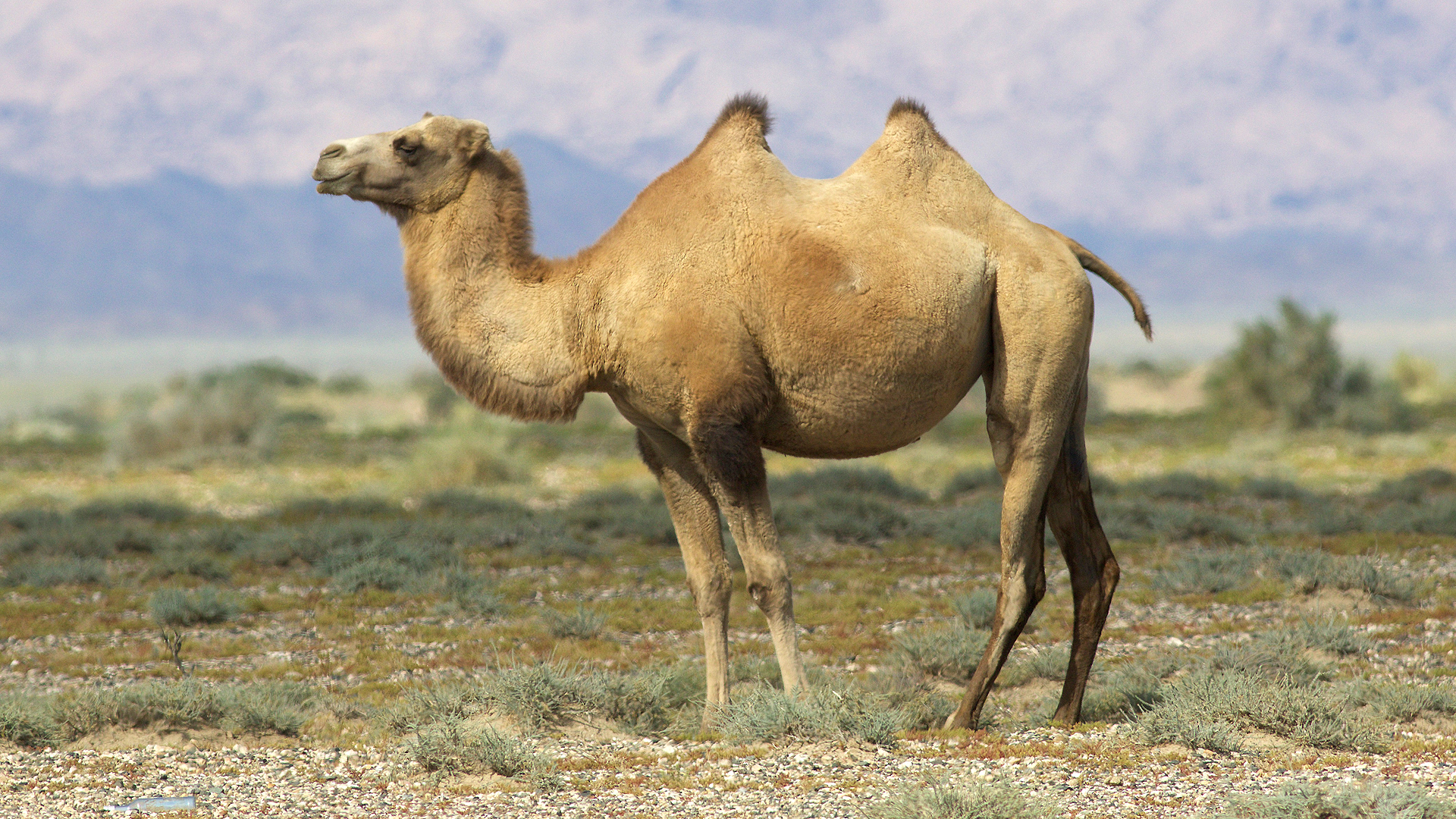
In 2006 I saw footage of Bactrian Camels in the Mongolian Gobi Desert on the BBC’s Planet Earth series. Oh how I wanted to go. And then I heard the details about how long and complicated the expedition had been to get the footage. I gave up on ever going.Somewhere across the world, fellow mammal watcher, Richard Webb was having similar thoughts. But, undeterred, and armed with a scope and a hot tip he visited Mongolia in 2015 and saw Camels. As soon as I read his report I started making plans, and it didn’t take long to find some camel fans to join me. And in early September 2016, Phil Telfer,Paul Carter and I arrived in Mongolia. Unfortunately our fourth companion – Charles Foley– wasn’t able to make it in the end.We took Richard’s advice on both the itinerary and tour operator and we too used the fabulous Khumbaa Tumendelger (Tumen) and Oyunaa Bavuu (Oyunaa) of Tumen Ecological Tourism Company (also here on Facebook) to organise the trip. Richard’s report sang Tumen’s praises but noted a few areas for improvement. Many of these areas seemed to have been improved upon: Tumen is getting more experience of this remote region now (though we also ran out of fuel one day).Oyuna in particular speaks excellent English so communication before the trip by email worked pretty well: Tumen and Oyuna will reply to messages, though sometimes it can take a week or two if they are somewhere remote. As with all things in Mongolia, patience is a must.
Phil and Paul planned to arrive before me to travel for a few days before we met up. But I had only two weeks and my priorities were Camels, Long-eared Jerboas, Polecats plus as much other new stuff as I could find. Our rough itinerary was to spend 5 days in the Gobi Special Protected Area A looking for Bactrian Camels and Gobi Bears, then a couple of nights at Ulan Kharee for Long-eared Jerboas and then to Yolyn Am for two nights to look for Polecats. I would spend my last night at HustaiNational Park, near Ulaan Bataar, for Przewalski’s Horse. The beauty of Mongolia is that you can camp (and drive) just about anywhere so we had a lot of flexibility to change things as we went. Travel times between sites were quite long and difficult to predict.
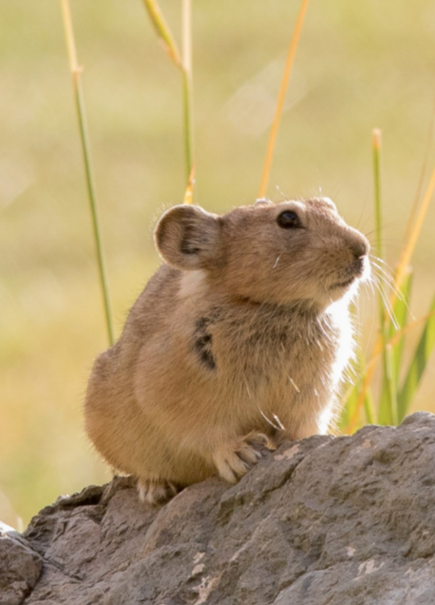
Some things to note
Mongolia exceeded my expectations by a long way. And my expectations were high. It is mammal watching nirvana.
Travel
Early September was a good season to travel. It probably got up to the mid 30s in the Gobi but there is no humidity and the nights were pleasant. Ground squirrels, marmots and jerboas were still active but I imagine it might be a different story two or three weeks later.Travelling in the south of Mongolia is largely by road. There were rumours of flights between Ulaan Bataar (UB) and Altai City and from Dalanzadgad to UB. But these flights did not materialise. Airline scheduling seems to be done on a whim and at the last moment.We spent most of the time driving on dirt roads, dirt tracks, or just dirt. In the Gobi in particular there are no roads as such. Just a cobweb of impressions on the landscape that may – or may not – lead somewhere. The bad news is that we frequently lost the track and had to turn back. The good news is that if you do lose the road you can start a new
one. Which we often did.
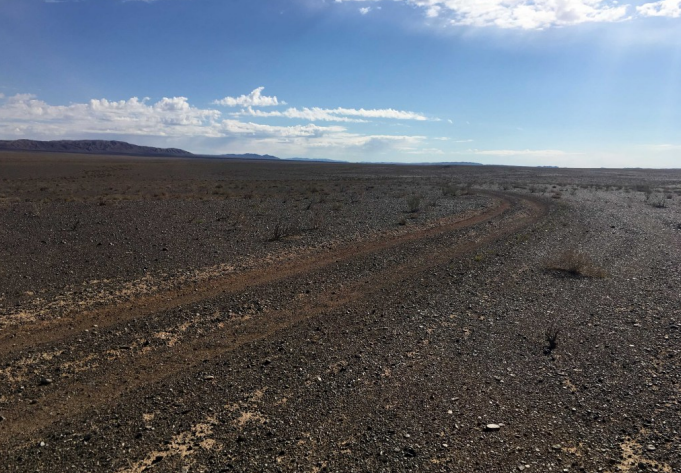
Food and Drink
Mongolian Beer is pretty decent. Especially when the alternative is no beer. I also learned that warm beer tastes pretty good if the alternative is no beer.Tumen’s wife, Oyuna, is an excellent camp cook and we ate well. I don’t think we ate much that was traditionally Mongolian other than the cheese. Some came in a plait of cheese strings and was pretty decent, albeit intense and salty. Another cheese came disguised a bag of pebbles and tasted a few days past rancid. I avoided anything that looked like it might have come out of a horses teat: fermented horse milk is a local delicacy; long may it stay local.
Books and Other Gear
A Field Guide to the Mammals of Mongolia by N. Batsaikhan and many others (published by the Zoological Society of London in 2014) is a complete field guide to the local mammals and extremely useful. I don’t know whether you can buy it outside of the country (I couldn’t find it easily) but it is available at the aiport and at Hustai National Park (for half the price). I also brought The Fauna of Hustai National Park from the Hustai park gift shop. This seems to cover all the mammals there so it is useful if you are spending time in the park. I also took Smith and Xie’s 2008 A Guide to the Mammals of China along and found that a useful reference, particularly when agonising – for hours – over the ID of some of the jerboas and pikas. If our IDs are incorrect please correct me. We had 50 Sherman traps with us and set them most nights, baited with either sunflower seeds or the standard peanut butter and oats mix. Hamsters, gerbils and voles were quite easy to capture. Jerboas were not (we caught 1 in 600 or so trap nights). We also made sure we had time to spotlight every night even if that meant stopping before we reached our destination for the day … though as our destinations were usually pretty vague this wasn’t much of an issue.
The Trip
Day 1: Ulan Bator -> Bayanhongor
Tumen and Oyuna were already travelling with Paul and Phil on their pre-trip, and so a second vehicle was meant to meet me at 7am. When they hadn’t shown up at 7.30 I was getting anxious. But Oggy, the unstoppable driver, and Eguut, “the helper girl” arrived shortly after: neither spoke much English but if I understood correctly one of them had gotten stuck in an elevator. We were on our way at 8am aiming to drive 800km south west to the end of the tarmac and the town of Bayanhongor for the night.
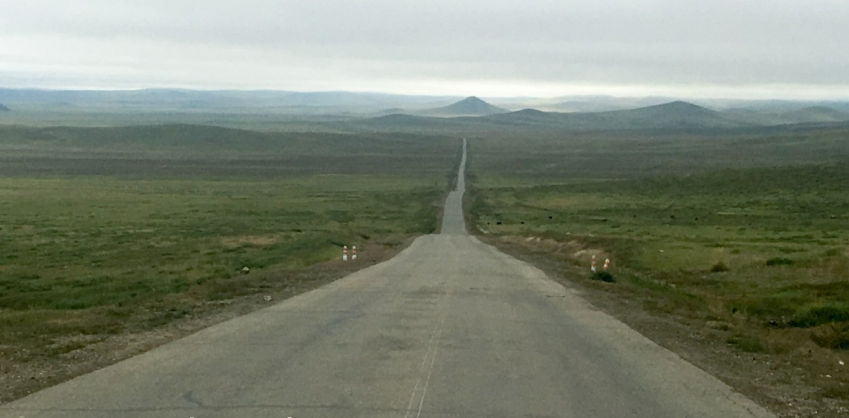
I wasn’t expecting to see many mammals en route, but a cold wind and recent drop in temperature may have been the reason that I saw nothing during the 10 hour drive through empty steppes. Brandt’s Voles, at least, should have been common along theroad. Though we had planned to camp, the weather was cold and we were tired so I spent the night a hotel and enjoyed a bed and working wifi for the last time for a couple of weeks.
I’d originally planned to meet Paul and Phil in Altai City (about 6 hours’ drive from Bayanhongor) and – from there – we would head to Sharga Nature Reserve to look for Saiga in the afternoon. But I had already seen Saiga in Russia a few years earlier and so we decided instead to save time and rendezvous in Tseel City. This journey ought to take about 6 hours … or so we thought. It took 12. This was my first experience of the Mongolian national pastime of under-estimating travel time. I suspected it wouldn’t be the last.
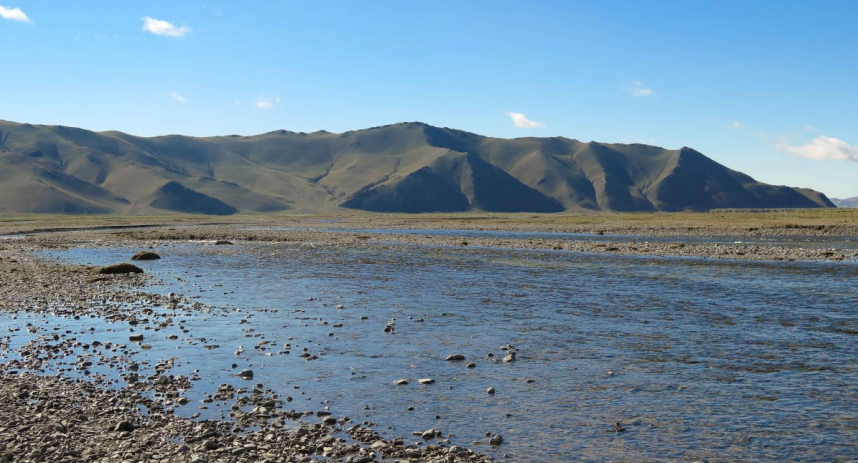
I spent the first couple of hours looking in the Tuin River Valley for Brandt’s Voles and other stuff. Thankfully Richard’s report gave good directions as, when I thought my crew had finally understood what I wanted to do, they took me to a small square rectangle of fenced grass by the river that was probably the tow park. To get to the valley, head north at the eastern end of the bridge crossing the river immediately before the town checkpoint (when coming in from Ulaan Bataar).
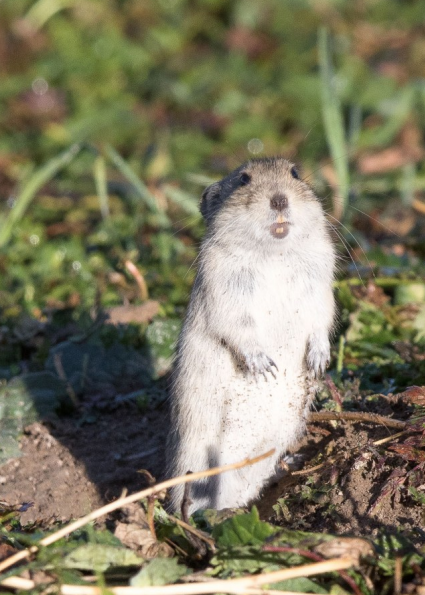
The valley was pretty, though nothing special by Mongolia’s high standards. I saw a bunchof Brandt’s Voles in several places you could hear them chirruping from underground pretty much everywhere. I wanted to head higher up the valley to look for Silver Voles and Pikas but it was too hard to explain this to Oggy the driver who did not speak even a word of English but was a master of charades. And so – after a distant Corsac Fox – we headed out of town. An hour, and several shopping stops later, we were on our way to Tseel City.
The next 5 hours were spent driving at breakneck speed across a tickertape parade of dirt tracks that had been splattered across the short grass desert. Tracks randomly branched off and came together but for the most part our Oggy knew where he was (or at least his GPS did). The only mammal was a single Red-cheeked Ground Squirrel that crossed the road in front of us about 90 minutes after we left Bayanhongor. We stopped to take a picture but before I could get my camera Oggy was on the roof of the car checking the roof rack. No more squirrel.
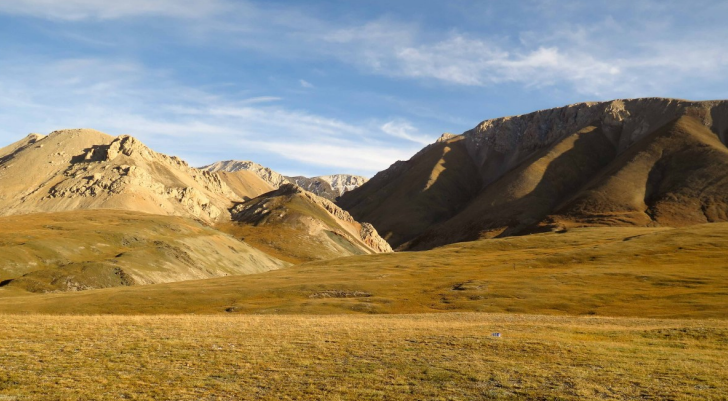
By 5pm we started climbing up through the Altai Mountains. I imagined we must be quite close to our rendezvous point. After some discussion it seemed we still had 200kms to go, which was about as far as I thought the whole day’s journey had been supposed to be! Not much to do but sit back and enjoy the wonderful scenery. I spotted a few Marmots in the high meadows in the early evening along with a large colony of Brandt’s Voles.
At 11.30pm we limped into Tsell City and met Tumen, Oyuna, Paul and Phil. Phew. They hadn’t arrived much before me and had gone for a brief spotlight and caught a few Balikun Jerboas, quite possibly the same large Jerboa species I had seen on the road just before we arrived.
Problems with a radiator in one of the vehicles meant we didn’t end up leaving until 3.30 today so we spent the morning lazing by camp and I caught up with Paul and Phil’s adventures of the previous week.
Tumen had arranged to meet with Sergey, a Camel researcher, at Mother Mountain so we stopped in there, encountering a few small groups of Black-tailed Gazelle on the 2 hour drive.
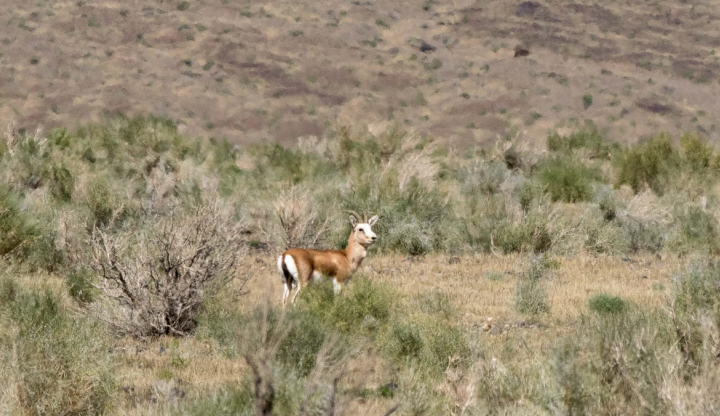
The Saxual “forest” around the mountain was alive with Great Gerbils.
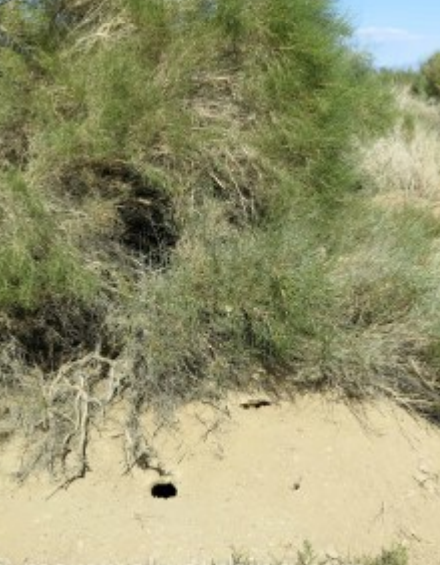
Their burrows – and their calls – were everywhere. It didn’t take long to locate a few wary
animals.
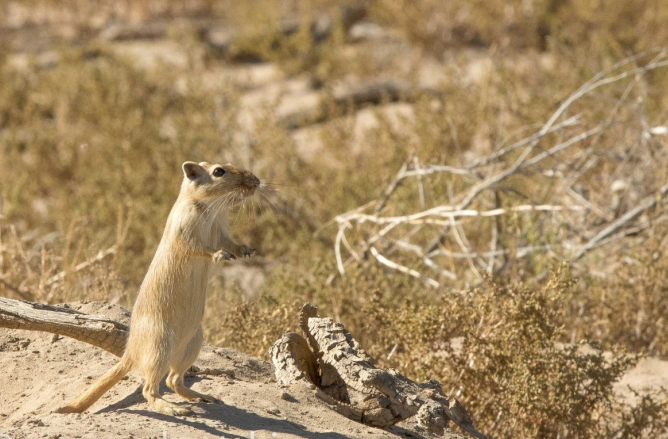
It was, by now, almost 7 p.m. and so we decided to stay the night rather than push on further. We set up camp by a ranger shack with a dramatic backdrop and set our 50 Sherman traps.
After a tasty dinner, Tumen drove us around the desert for some jerboa spotting. One of the great things about travelling with Tumen is his energy and genuine interest in the wildlife. He was always ready to spotlight for hours, no matter how far he had driven that night. And it was always us who asked him to turn around and head back to camp.
I’d read that jerboas are easy to catch by hand once they freeze in the spotlight beam and this proved to be the case, at least when Phil was in charge of the net. He only needed one attempt per animal. I was less successful and took about 10 swipes to finally bag a beast.
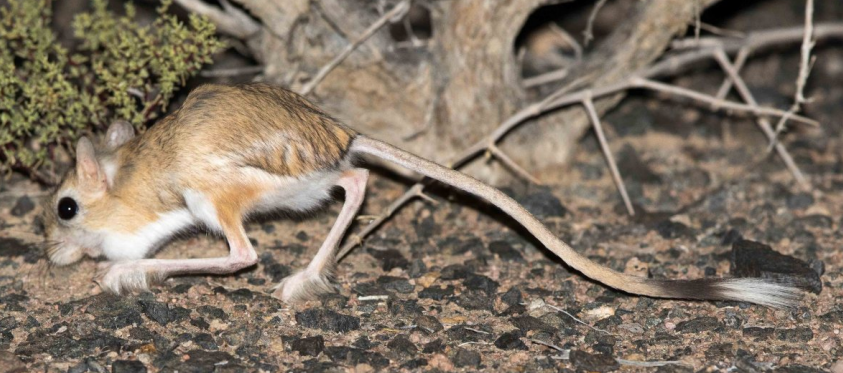
Northern Three-toed Jerboa, Dipus sagitta
The dominant species that night were Northern Three-toed Jerboas (or Hairy-footed Jerboa). We caught four by hand and saw several others. They do have very hairy feet
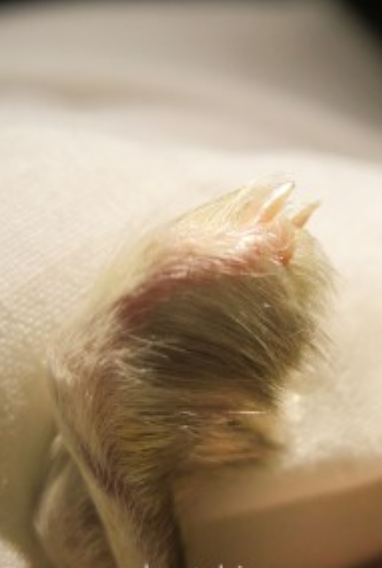
We also caught another superficially similar species, Andrew’s Three-toed Jerboa, which had a shorter tail with a much less pronounced brush
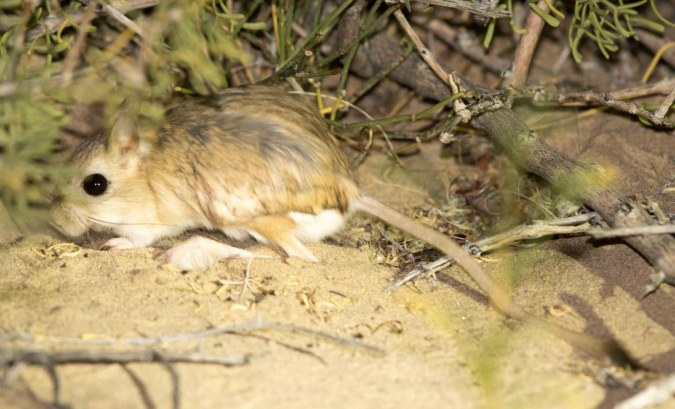
Andrews’ Three-toed Jerboa, Stylodipus andrewsi
The two species tails are quite different:
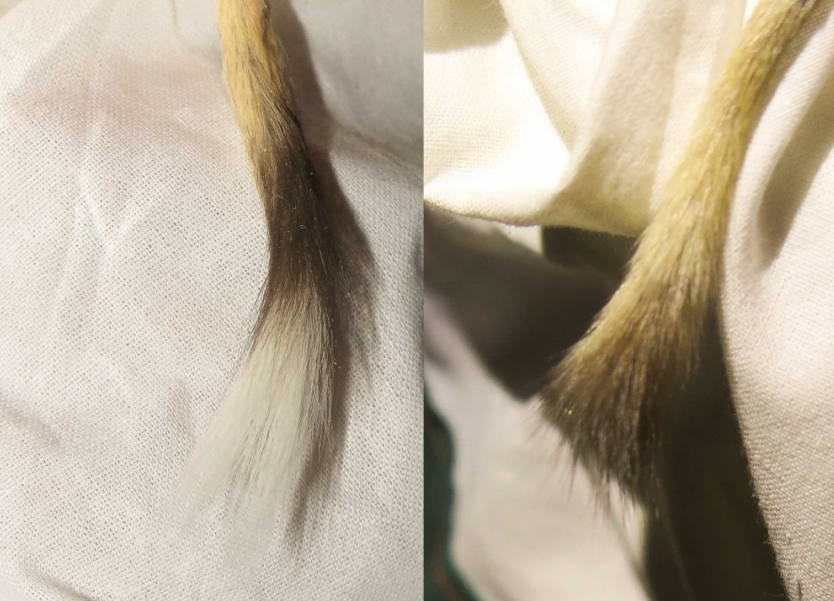
Other than a bunch of Midday Gerbils up towards the rocks and a couple of Tolai Hares, the only other mammal was a largish long-eared jerboa which we didn’t see for long enough to photograph or capture, but was either a Gobi, Balikun or Siberian Jerboa. Indeed these larger-eared jerboas proved hard to catch throughout the trip.
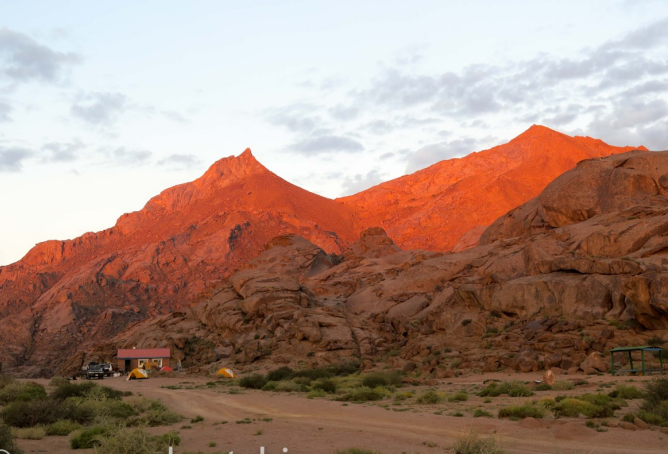
Dawn at Mother Mountain
The sun only started coming up at 7.30 so it was a fairly late start to check the traps. More than half the traps contained a Midday Gerbil though we also caught a couple of Grey Dwarf Hamsters, a species I had only seen once before when one ran under the wheels of my car in Turkey.
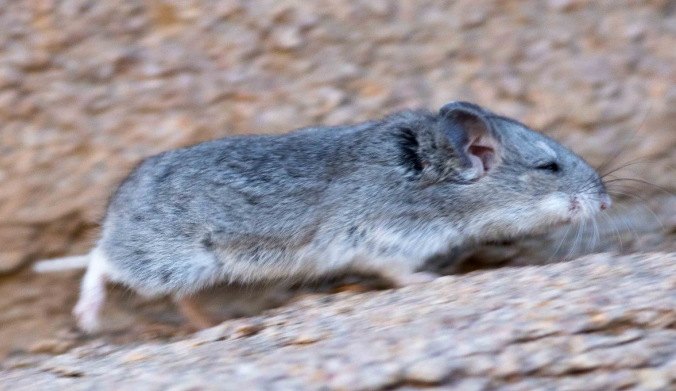
Gray Dwarf Hamster, Cricetulus migratorius
For several weeks before the trip Tumen had seemed remarkably confident about us seeing Camels. This puzzled me a little, given Richard’s group had had to work so hard.
But perhaps it was because we had a researcher and more information this year – because Sergey had seen camels driving up to Mother Mountain the previous day and seemed to think we would see them this morning. Just 30 kms out of Mother Mountain, Phil spotted a single camel that seemed to meet the wild description. Blondish, very small humps …Tumen confirmed it was definitely wild. Paul spotted another animal much closer that was moving towards us. It seems there are 20 or so camels living just north of the Gobi A reserve. The animals are being studied so are somewhat habituated. There are many domestic camels in the area too and I was puzzled as to why they didn’t interbreed but Tumen explained the herders have to remove their camels during the breeding season to maintain genetic purity.

Another 20 kms down the track we saw a large group of domestic camels with a wild one nearby. They were all heading in the direction of some springs and it was a great opportunity to look at the differences. Wild camels are unmistakably different with their longer, thinner legs, much smaller humps and a different forehead. They are also yellowish, and not the brown of the domestic variety, and had a different gait. A short, 20 second video is here.

Overjoyed to have had such close and prolonged views – though also a tad unfulfilled that we didn’t have to work a bit harder – we drove on to the well-kept little community of Buyantooroy for a long slow lunch at the research centre, where we could
ogle camera trap pictures of Gobi Bears, Lynxes and Snow Leopards.
We had had hopes of getting to Shar Xuls, the epicentre of bear habitat that night. But lunch took about 3 hours and we didn’t get on the road again until 4.30. Such is the way of things in Mongolia. Moreover, heavy rain in the mountains a couple of days earlier meant the usual route was impassable. So we drove east for 100kms before finally turning south. Realising we were not going to even get into the Gobi Reserve before dark we decided to break camp at a random spot in some sandy desert where Tumen noticed a multitude of small animal tracks.
Tumen, as always, was ready to go spotlighting after dinner. Not long after dusk we saw a Red Fox, and a few Northern Three-toed Jerboas plus another larger-eared species that we couldn’t catch. An hour later, once the sliver of a moon had set, we saw our first, very cute Desert Hamsters.
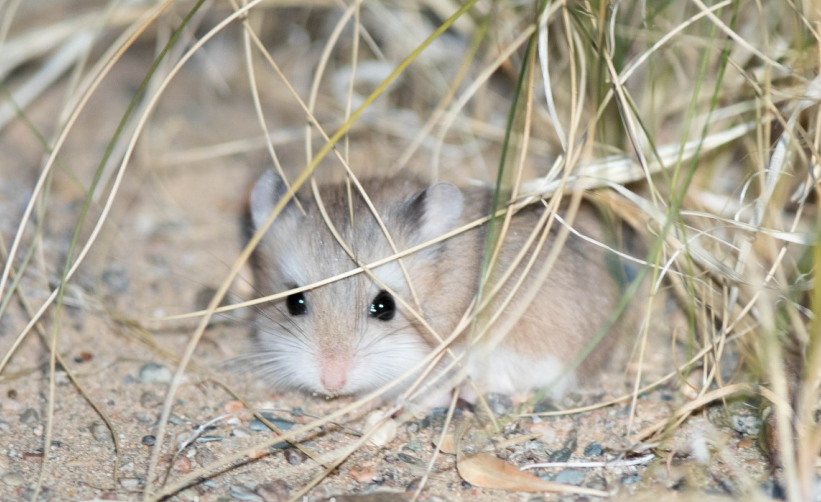
Desert Hamster, Phodopus roborovskii
After more jerboas (we still weren’t able to catch the larger-eared species), we saw two pygmy jerboas no more than 3 metres apart. We caught both by hand and – though superficially similar – they were different species. The first had three toes and a longish tail with a tuft on the end: Koslov’s Pygmy Jerboa.
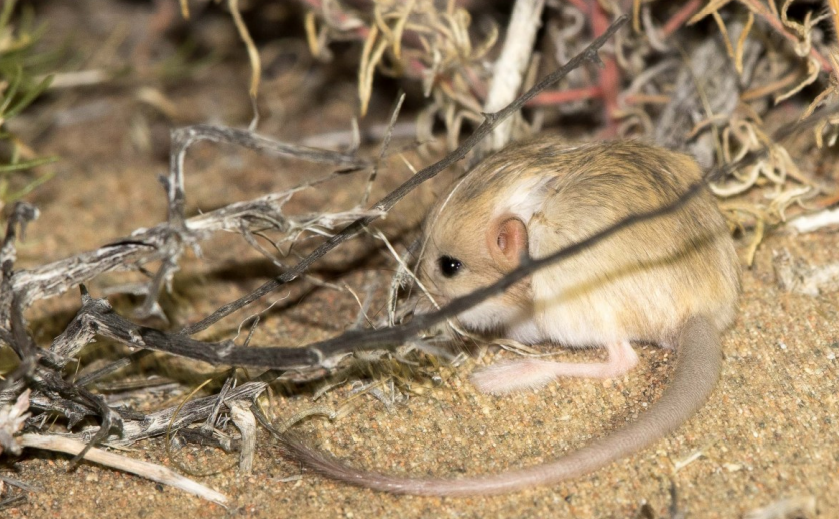
Kozlov’s Pygmy Jerboa, Salpingotus kozlovi
The second had a shorter chubbier tail and, crucially, five – very obvious – toes on the hind foot.
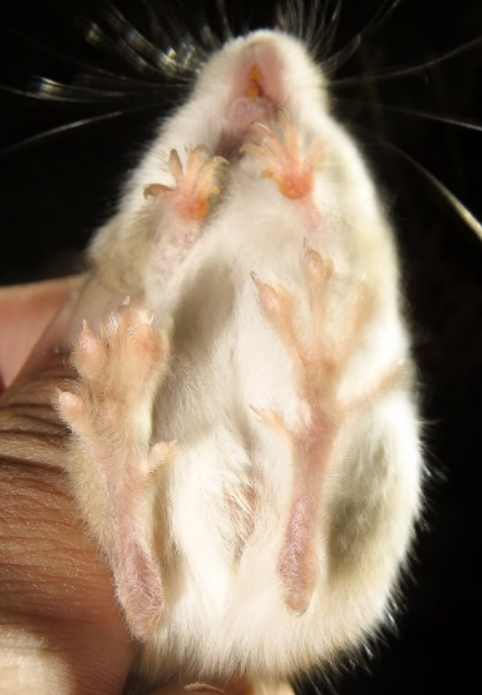
Five-toed Pygmy Jerboa, Cardiocranius paradoxus
A Five-toed Pygmy Jerboa.
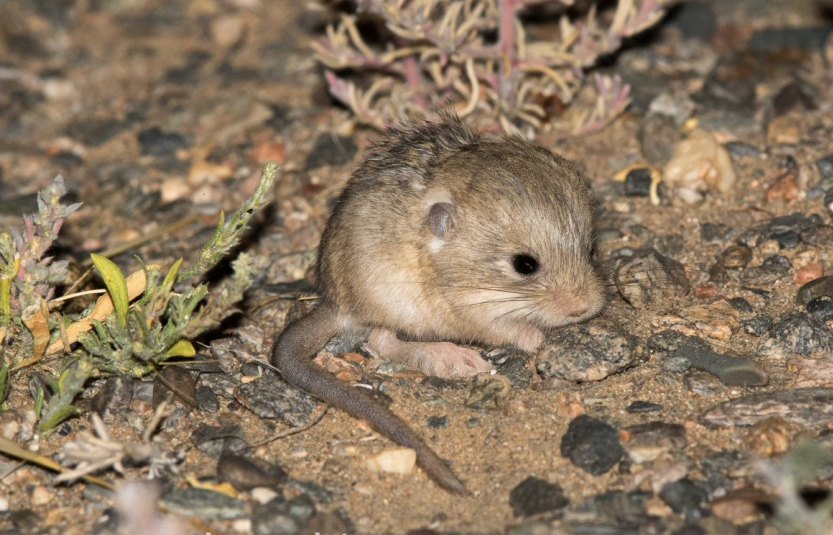
Five-toed Pygmy Jerboa, Cardiocranius paradoxus
Both new for me. Ten minutes further on we saw two more jerboas. One was another Five-toed Pygmy but the other was different: it was, again, a pygmy jerboa with three toes. But, compared to Koslov’s, it had a shorter, chubbier and tuftless tail: a Thicktailed Pygmy Jerboa.
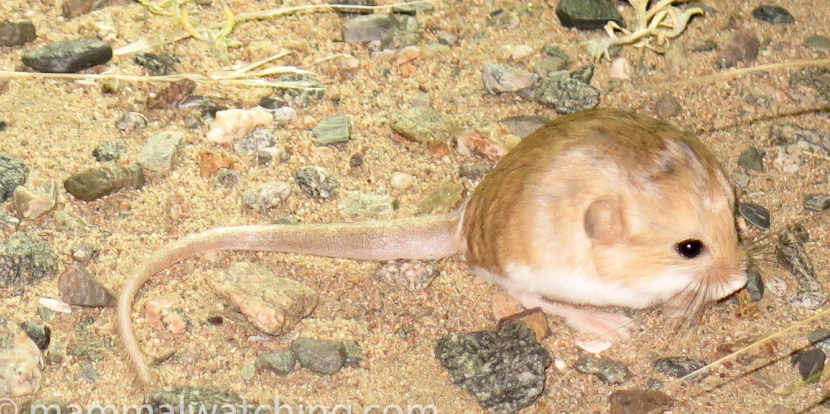
Thick-tailed Pygmy Jerboa, Salpingotus crassicauda
It is unusual to catch four animals close together that look to be the same but in fact comprise three different species.
The drive today was only 140 kms as the Golden Eagle flies. But it took all day: largely because Tumen had never travelled this route before and we were navigating off a mud map Tumen had been given. Thankfully Paul also had the GPS coordinates for Shar Xuls, the Gobi Bear research station. Without them we might still be en route. When I got back from Mongolia I decided that getting a little lost – and out of one’s comfort zone – is all part of the Mongolian experience: how else could we really appreciate the solitude and remoteness of the Gobi?
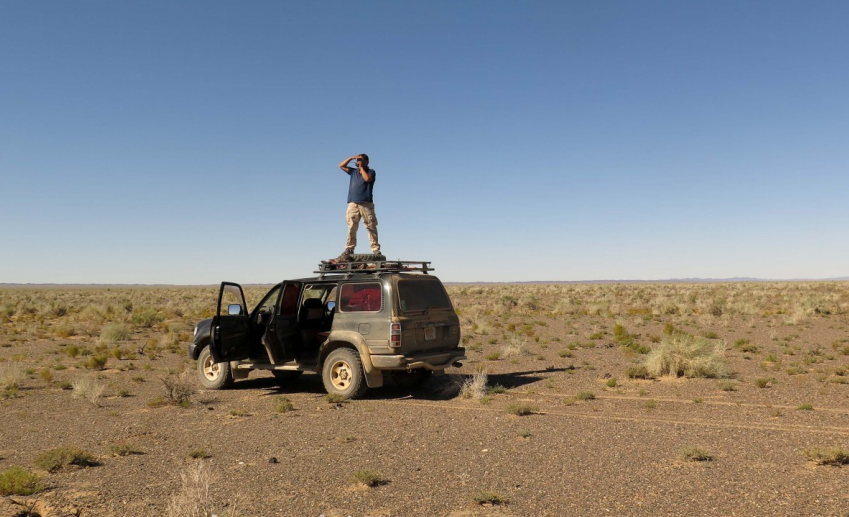
Tumen looks for a road
A few small groups of Black-tailed Gazelles fled from our vehicles on the drive in, as did ten or so Argali in the last range of hills before Shar Xuls.
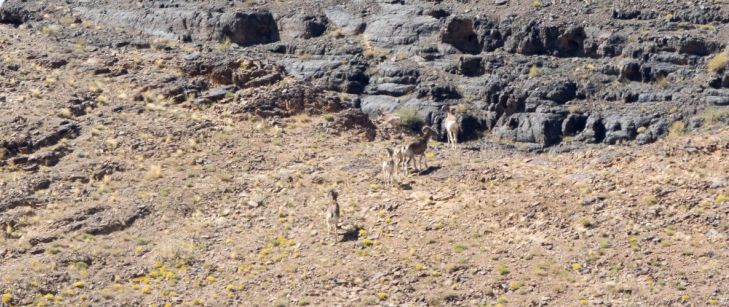
Argali, Ovis ammon
A few hundred metres before we arrived at Shar Xuls we spotted a Wild Camel that too fled when we spotted each other. This distant sighting completed my camel watching expectations. I was happy to have had both this “authentic” wild camel sighting as well as the much closer and more prolonged look at the semi-habituated animals outside Bayantooroy.
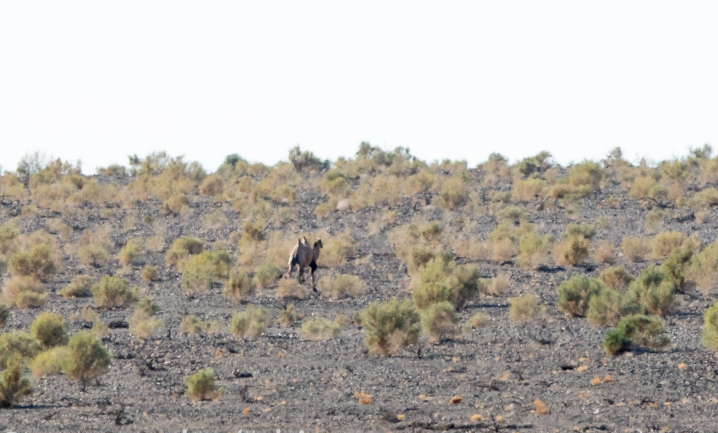
“Original” Wild Camel, Camelus ferus
When we arrived at Shar Xuls we expected a bear researcher to be waiting for us. In fact Tumen had said originally that a bear researcher would accompany us in his own vehicle from Buyantooroy. There was no researcher waiting.
Explaining changes of plans is not Tumen’s strongest point, but we later discovered that the bear research crew only had two vehicles. One had broken down and the other was accompanying an American scientist. So we would not have the help of a researcher. Given there are only about 25 of the critically endangered Gobi Bears left, a subspecies of Brown Bear, this was a problem. Strike 1 for bear watching.
Shar Xuls comprises a small bunker/house built into the rocky slopes, a large oasis of tall grass and Gobi Poplars, a bear feeding station and a camera trap. We visited the springs in the late afternoon to take a “natural shower”. I had romantic ideas of a waterfall cascading over the rocks but no, this was a far from natural white hosepipe spewing ice cold spring water. Oh well… After half-heartedly failing to improve my personal hygiene I caught a tiny snake by the edge of the track that Tumen got excited about: a Tartar Sand Boa and apparently quite rare.
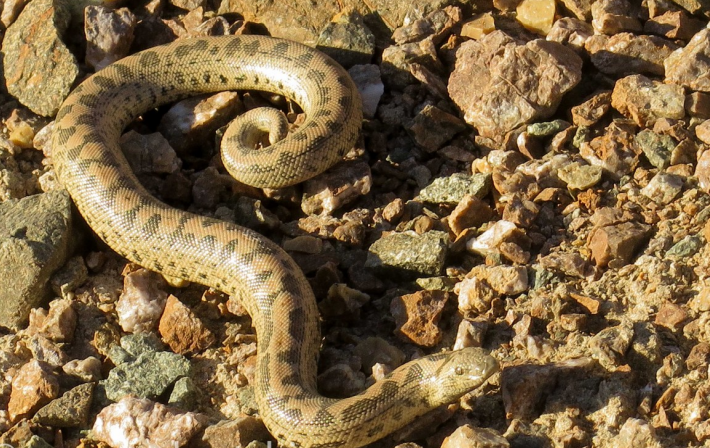
Tartar Sand Boa
Richard Webb’s report urged prompt checking of the camera traps. We tried, but for reasons I didn’t fully understand this didn’t happen. Instead we walked 20 minutes after sunset up a hill that was overlooking the feeding station. The absence of any serious moon meant it was impossible to see much below us. Worse, the feeding station was several hundred metres away and out of range of our spotlights. After a couple of hours the chances of seeing a bear were increasingly futile and one by one we abandoned our lookout to return to camp (finding the route back in the dark was a lot more complicated than I’d expected and a GPS would have been helpful).
Paul and I walked back to the springs and long grass by the “natural shower”. It was a productive area for small mammals, with a Northern Three-toed Jerboa, a Midday Gerbil, a tiny shrew and a Thick-tailed Pygmy Jerboa.
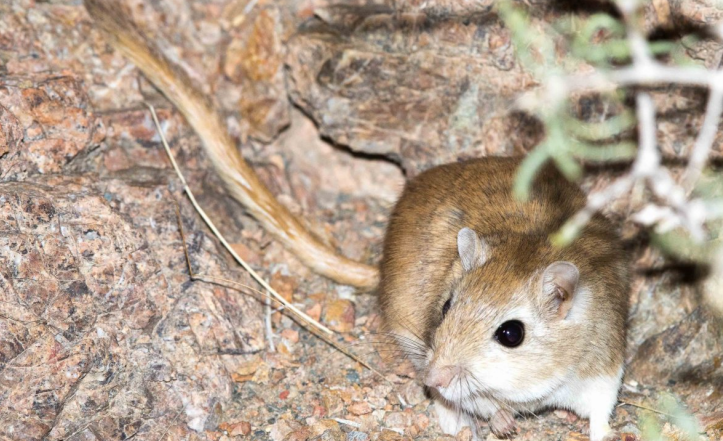
Mid-day Gerbil, Meriones meridianus
Best of all, Paul found three Long-eared Hedgehogs at the edge of the trail next to the springs. We watched them bumbling about in the trackside vegetation before one came to drink at the pool for several minutes.
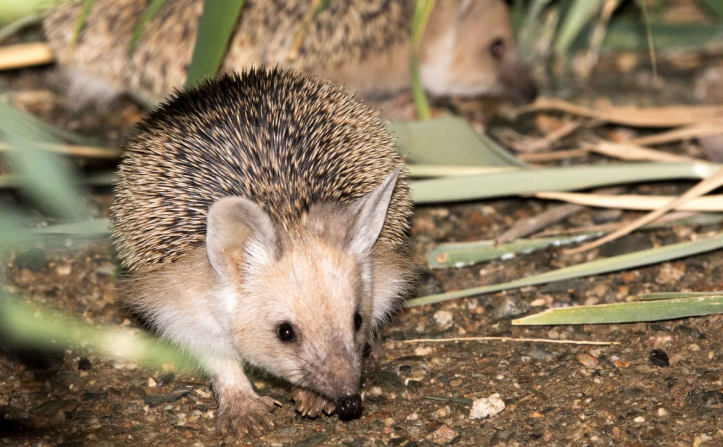
Long-eared Hedgehog, Hemiechinus auritus
I am pretty sure a Long-eared Hedgehog was snuffling around my tent at 4am but I couldn’t spot it.
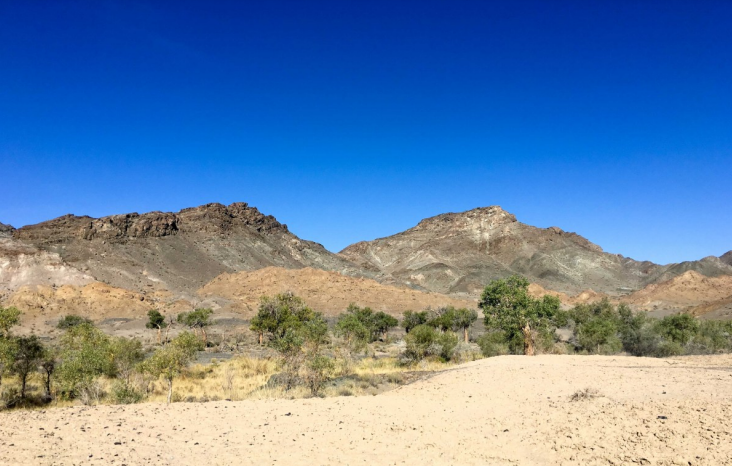
Shar Xuls oasis
We wanted to stay put today, for the first time on the trip. After breakfast we went to check the camera traps to see how frequently bears were visiting. There were lots of scats, though none very fresh, and the cameras were locked. Strike 2 for bear watching. Worse, much worse, we learned that the feeding station was empty. Last year, when Richard had visited, it sounded like the bears had been fed continuously. This year it seems that Government cuts – or mismanagement – meant there had been no food since the spring. Three strikes for bear watching.
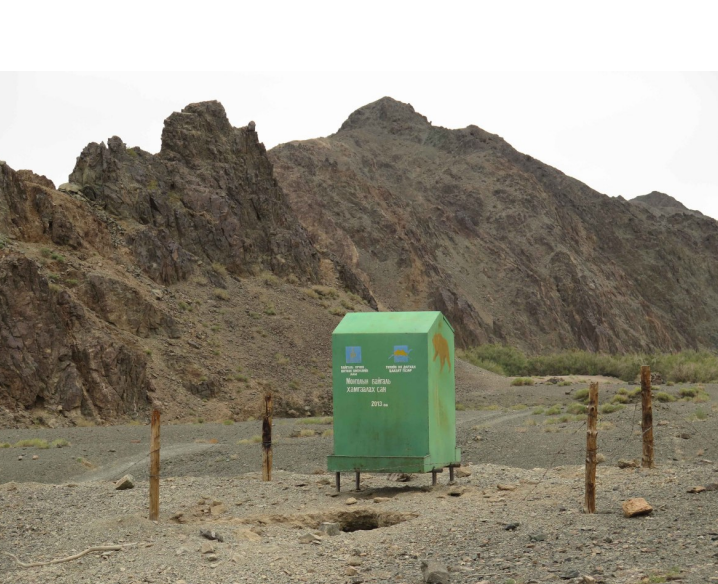
An empty bear feeding point
We did see a flock of Argali and fresh evidence of Wild Ass, Ibex and Camels as well as less fresh bear poop. It seems bears crap in the rocks as well as the woods.
We spent the late afternoon scanning for animals. We saw nothing and plans for a spotlight drive evaporated when Tumen didn’t appear, sending a message that he was worried about running out of fuel. Later we were told that spotlighting around the valley was forbidden by the bear researchers. Who knows…
So we set up a mist net and caught a single bat – an extremely placid Alashanian Pipistrelle – and saw more hedgehogs.
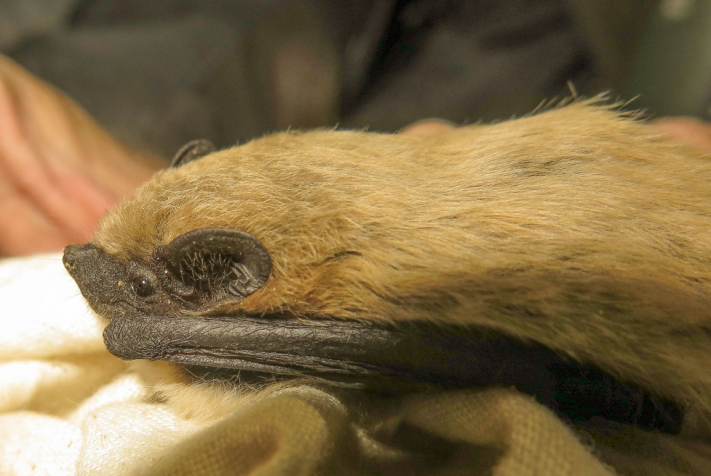
Alashanian Pipistrelle, Pipistrellus alaschanicus
Walking back the couple of miles to camp produced nothing other than a couple of Tolai Hares.
After a late start to the day we broke camp and collected the traps. A few Midday Gerbils and Grey Dwarf Hamsters, three Long-eared Hedgehogs (hedgehogs are surprisingly easy to trap) and – best of all – a small shrew out in the rocky desert several hundred metres from the oasis. According to the Mammals of Mongolia only the Lesser White-toothed Shrew is in the area and the measurements fitted (tail 30mm, HB 65mm and HF about 10mm). But I found it hard to believe that the same creature of French gardens is in the middle of the Gobi and the Mammals of China book confirmed that the species here is in fact now split: Gmelin’s Shrew. A feisty little thing and it was great to see if tear off back into the rocks when we released it.
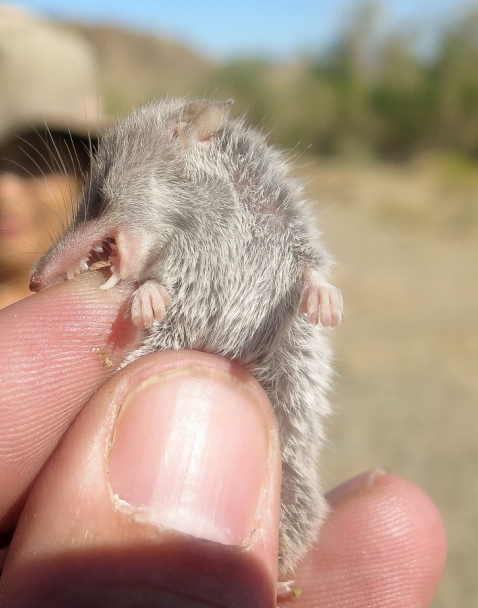
Gmelin’s Shrew, Crocidura gmelini
Having effectively given up on the bears we thought of heading 100km or so towards Gurvantes and spending the night in Long-eared Jerboa habitat. But when we reached the second bear feeding station – about 15km east of Shar Xuls there were many fresh Ibex and Ass droppings and reasonably fresh bear prints. Tumen was keen to spend the night and so we agreed to give the bear one more shot.
We climbed a steep and extremely slippery scree slope above camp in the afternoon and scanned for several hours. The only animals were a few distant Argali. Tumen and Oggy spent the night up there but saw nothing more. A bit of a waste of a day but a beautiful place to waste it in.
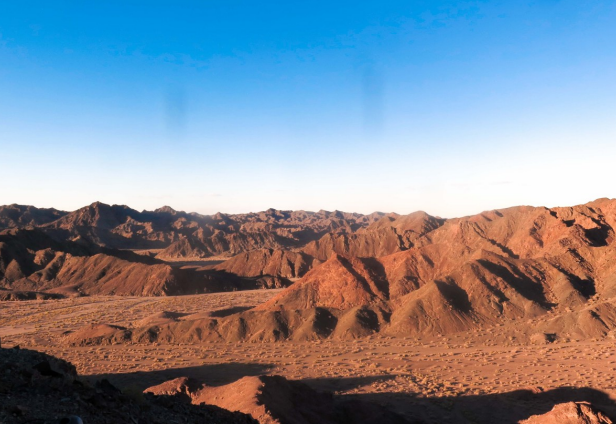
After three days in the area we were ready to start heading east towards Gurvantes. Six Argali made an appearance on the valley floor before we left giving the best views so far of this species. A few kms further on we stopped to look at a Black-tailed
Gazelle and Paul spotted our first (and last it turned out) Wild Ass. This was Phil Telfer’s 899th mammal.
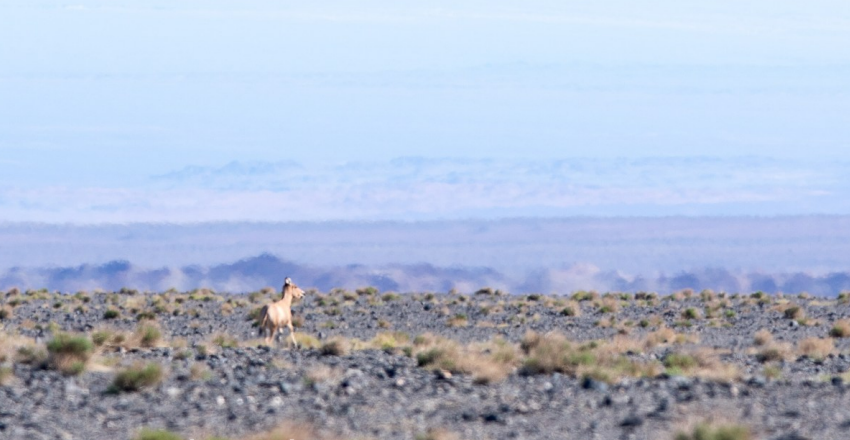
Asiatic Wild Ass (Kulan), Equus hemionus
We wanted to spend the night at Eyhin Gols. Paul had found a paper recording this small oasis and agricultural settlement as a site where Long-eared Jerboas had been captured some time ago. Although only 90kms away it took all day to get there. The vast emptiness of the Gobi was able to distract me – most of the time – from our dwindling fuel supplies. It was still 300km to Gurvantes and we had under half a tank to get there.
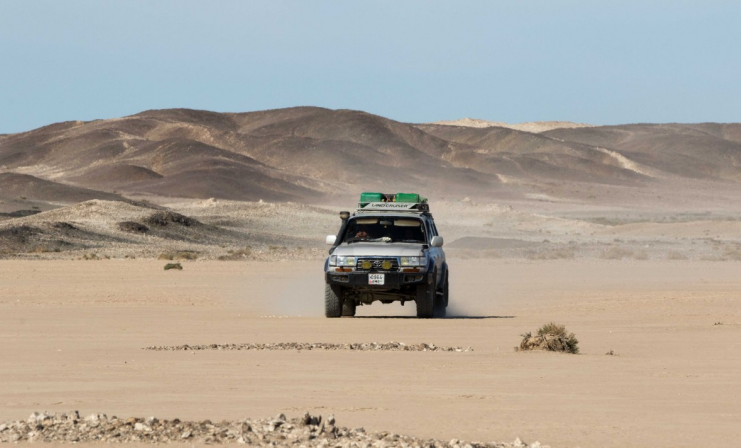
After lunch we stopped for a chat with a few “Ninjas” – the inventive nick name for Mongolia’s unauthorised gold miners whose small, illegal, excavations are scattered throughout the Gobi. They miners are so named because they carry their gold pans strapped to their back, like the shell of a Ninja Turtle.
We got into Eyhin Gols about 4pm. We were able to buy fresh vegetables but no one had any diesel. We camped a few minutes out of town on some pebbly flats which Tumen pronounced to be good Long-eared Jerboa habitat.
Spotlighting produced a bunch of Plated Geckos which had distractingly bright eyeshine.
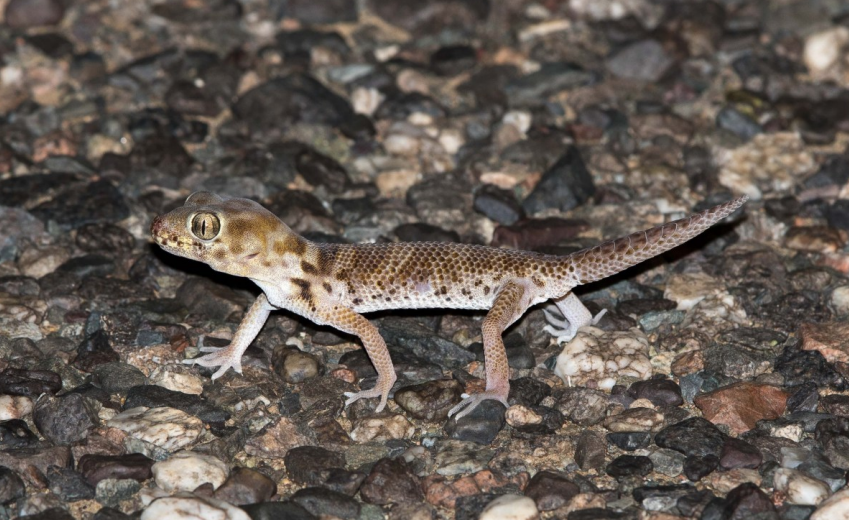
Plated Gecko
A couple of kms from camp we spotted our first mammal: a Long-eared Jerboa! After a long chase we were able to capture it in a net and get a close look at this truly fabulous and – let’s be honest- ridiculous mammal. Definitely a highlight of the trip. The pictures speak for themselves and a worthy species for Phil’s 900th.
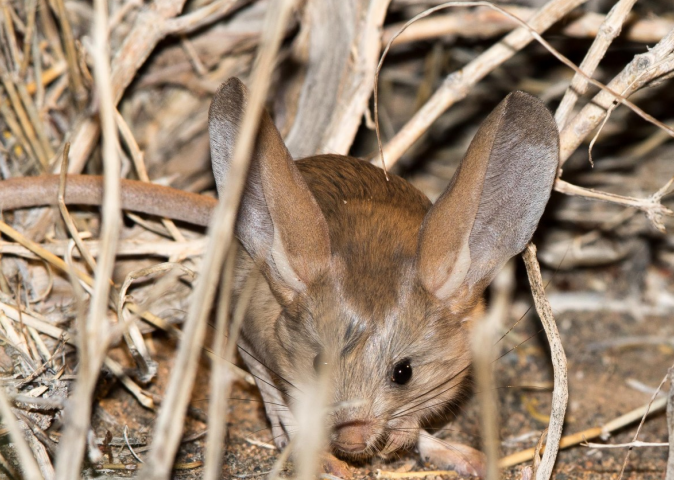
Long-eared Jerboa, Euchoreutes naso
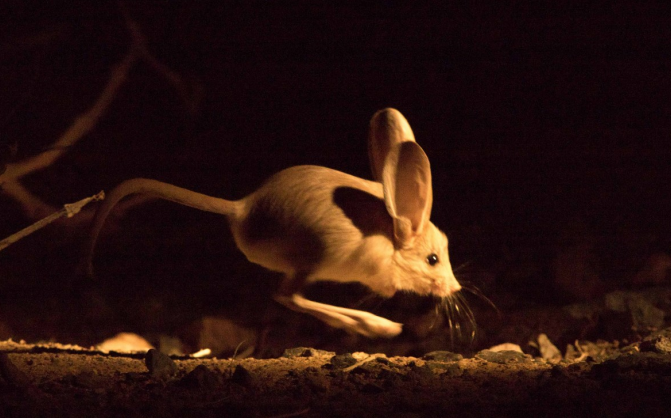
Long-eared Jerboa, Euchoreutes naso
Jerboas were few and far between but in the next 2 hours we saw another 4, all of which had large – but not ridiculously large – ears and appeared to have been Siberian. These were difficult critters to capture… seldom freezing and generally moving from bush to bush at speed before disappearing.e also saw just one Midday Gerbil. Back at camp we had a warm beer with Phil to celebrate his 900th mammal.
We also celebrated the decision to stop in Eyhin Gols. Scoring the jerboa meant we no longer needed to drive many hours out of our way to Ulan Kharee. Moreover this was: a species I had understood was going to be easy to see but which Tumen later informed us is far from guaranteed in September, so one in the hand is definitely worth two under a bush!
Yet again the traps held several Midday Gerbils and a probable Desert Hamster which got away before a definitive ID. I had imagined jerboas would be easy to capture – but it appears they are more wary than other some of the other hopping rodents (Kangaroo Rats, Gerbils and Hopping Mice for example).
Our next stop was the town of Gurvantes, where thoughts of a hot shower and a restaurant beckoned us as we sped, now on a better track, past more Black-tailed Gazelles.
First we had to get there. Our fuel supplies were low. One of the vehicles in Richard Webb’s group had run out of fuel 120 km west of Gurvantes last year so I had imagined we’d have ample supplies. But this was Mongolia. And our car ran out of fuel 70kms before Gurvantes. Sigh. Luckily we were now in an area with people: a few Gurs dotted the hillside and Tumen did not seem remotely concerned. Our second vehicle had enough fuel to reach a phone and call for supplies from Gurvantes which were sent to meet us. It did cost us four hours though and if you follow the same route as we did I strongly suggest
that each car carries a spare 60 litres of fuel, not the 30 we were carrying.
We rolled into Gurvantes at about 6pm to learn that the whole town was without electricity and had been for a couple of days. No hot shower. No restaurant. No cold beer. But one of the profound life lessons of the trip was that warm beer is OK if the alternative is no beer. So we bought a few bottles and a ton of chocolate and pressed on east.
We had a vague plan to getting to Zoolon Mountain – north of Sevrey Mountain – that night but we didn’t know how long it would take to get there. Zoolon was anything between 20km and 90km from Sevrey depending on who you asked. We decided to drive and spotlight along the way and see what happened. But first another “average” (for Paul Carter at least) sunset.
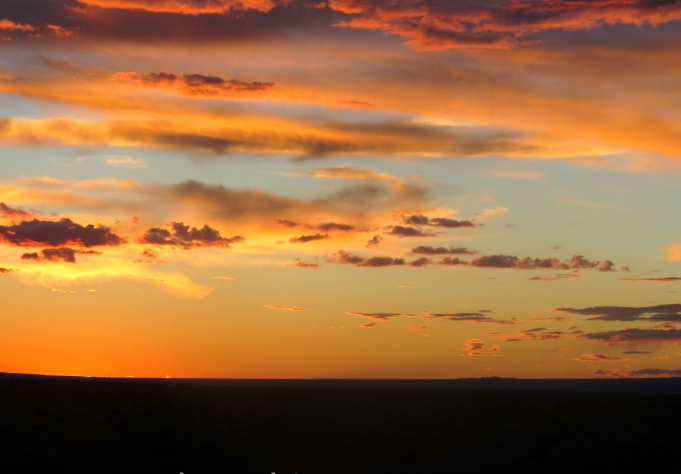
Average sunset
We spotlit – at speed – for four hours. We saw several of the larger – and large-eared –Jerboa species (either Gobi, Balikun or Siberian Jerboas) but they remained hard to capture: if we were able to get within striking range they would, more often than not, speed back to their burrow as soon as the net started to swoop. We managed to grab just one– which Paul caught by hand – but it got away before we could examine it closely. For these three species at least, it might be better for IDing to take plenty of photographs first before trying to capture one (tail pattern and ear size is diagnostic). This species appears to be a Balikun Jerboa – suggested by the size of the ears (too small for Siberian) and the narrow band of white at the base of the tail flag and the wavy pattern to the fur (both of which are indicative of Balikun rather than Gobi Jerboa).
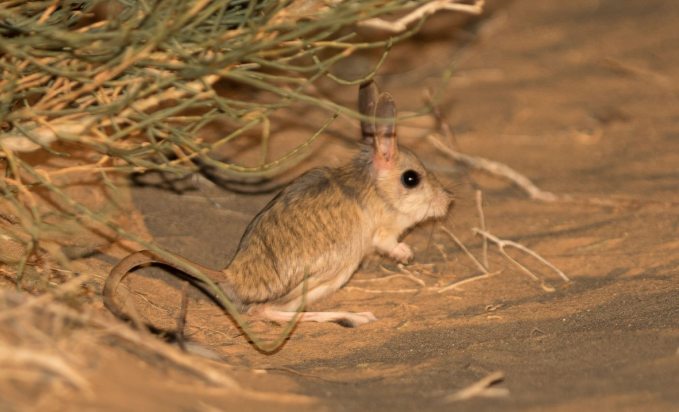
Balikun Jerboa, Allactaga balikunica
The next species we photographed looked to be Siberian – the much larger ears (longer than the head) are evident.
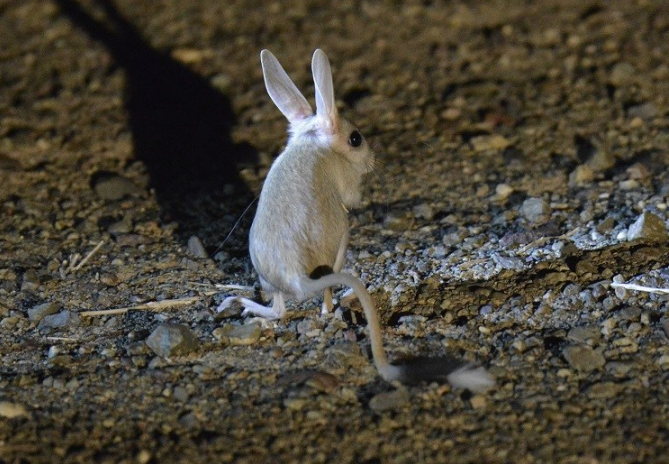
Siberian (Mongolian Five-toed) Jerboa, Allactaga sibirica. Photo Phil Telfer
We saw many more larger eared animals, especially when we crossed stony ground with tiny, sparsely scattered clumps of grass. These may have been Gobi Jerboas but we didn’t get any photographs to be sure. Easier to catch were the much smaller Koslov’s Pygmy Jerboa and the Five-toed Pygmy Jerboa we saw on the road.
By midnight it was clear none of us had the energy to set up camp so Tumen suggested we stay in a hotel in Sevrey. This was easier said than done when the whole town was also without electricity. But, after many phone, calls someone was woken up and the hotel opened for us.
Never has the idea of a hotel promised so much and delivered so little. After 8 nights camping it wouldn’t have taken much to feel like luxury but the small guest house failed big time. There was no hot shower. There was no running water. But at least I’d have a soft bed to give my hips a break after the last two nights’ camping on rocky ground. Surprise! The bed was a solid piece of wood – cunningly wrapped in cloth to give it the illusionb of a mattress, topped with a tissue-thin layer of cloth.
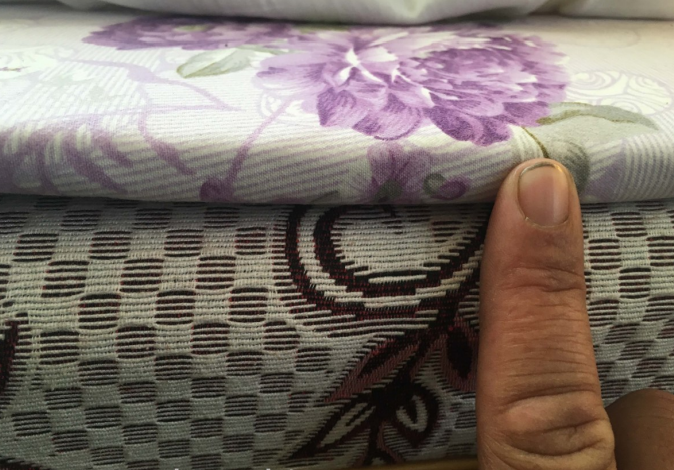
Part bed, part torture device. The checkered cloth covers solid wood. The 3 millimetres of fabric above it is the mattress
Oh well. There were still mammals to see and the morning didn’t disappoint as we drove past stunning mountains and through a couple of rugged gorges. Some new species were coming into range, as well as chances for Snow Leopard and Pallas’s Cat.
As soon as we stopped we spotted a few Pikas. Pallas’s Pika seems to be the only species in range here and the few animals we saw – in a couple of colonies – were denning on the sandy slopes just below the rocky hill tops. Daurian Pika – which come into range further east – are almost identical unless you can look at the pads of their feet. However I was later told that they are far more secretive, and spend a lot more time underground and are rarely spotted sitting still.
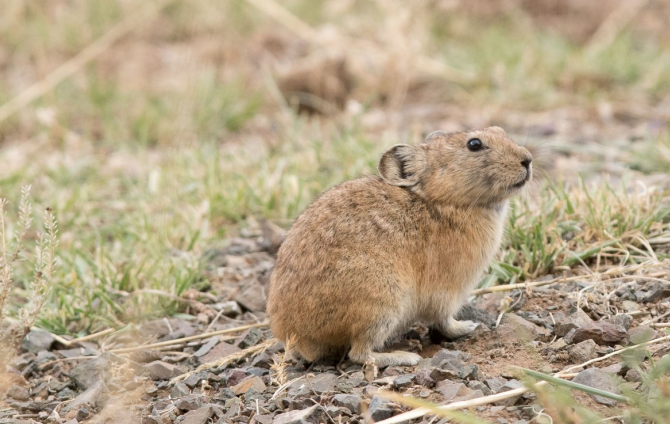
Pallas’s Pika, Ochotona pallasii
Phil spotted the first Siberian Ibexes of the trip – a couple of distant groups – and then we came across a colony of Ground Squirrels which were not the Red-Cheeked that Tumen had been expecting. Alashan Ground Squirrels! A quite local species that we might have struggled to see in Yolyn Am.
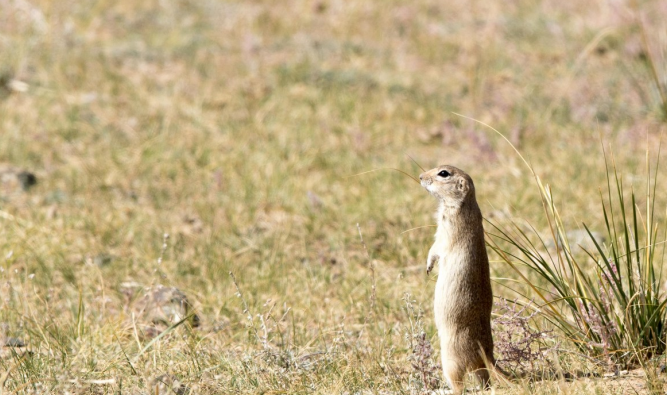
Ala Shan Ground Squirrel, Spermophilus alashanicus
We set up camp at 3.30 and devoured a 3 course lunch while scanning the rocky ridges for cats without success. Tumen and Paul climbed a ridge behind camp and came back at sunset to report about 2000 Mongolian Gazelles were scattered across the distant valley north of our camp. We would be driving that way tomorrow and would hopefully run into them.
We were joined for our nightly spotlight excursion by a local herder and friend of Tumen’s. He navigated us up a series of rugged tracks to a remote Ger which had lost a goat to a Snow Leopard two days earlier. Our spotlights found several Ibex, a couple of Red Foxes, two unidentified jerboas (possibly Balikun) and my first Wolf of the trip. But no cats, though we were told that just that morning the framer had been shooting at a Snow Leopard to scare it away.
For the first time we caught absolutely nothing in our traps and by 10 a.m. were on our way to Yolyn Am Gorge, stopping to scan for the Mongolian Gazelle that Tumen had seen last night. It didn’t take long to find a few and after a bumpy drive across a dozen sand dunes we were close enough to have good views of 20 animals. Paul pointed out that while Black-tailed Gazelles flee in a straight line, Mongolian Gazelles usually run in all directions.
It was a decided culture shock to see our first tourists in 2 weeks as we approached Yolyn Am Gorge. Though this area would be seen as wild by most standards it felt almost suburban after the Gobi.
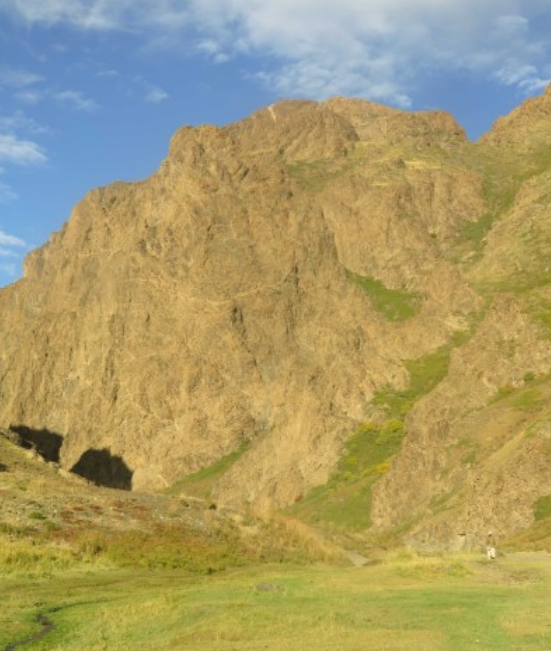
Yolyn Am Gorge
Yolyn Am is a well-known tourist attraction. It is an attractive mountain valley, with steep rocky sides and is apparently home to frozen water for most of the year. Although it is scenic it didn’t seem all that more scenic than many of the other beautiful places we had seen in the past two weeks so perhaps it is more the ease of access which makes it attractive.
But who cares about the scenery: the real reason to visit Yolyn Am is for the mammals! The valley is home to extraordinary numbers of pikas and gerbils. The gerbils comprised two species: Mongolian and Midday Gerbils and you didn’t have to spend more than a couple of minutes looking to see one or the other. The Mongolian flavour are distinguished from Midday by their tuftier, darker tails and dark claws (Midday Gerbils have yellow claws).
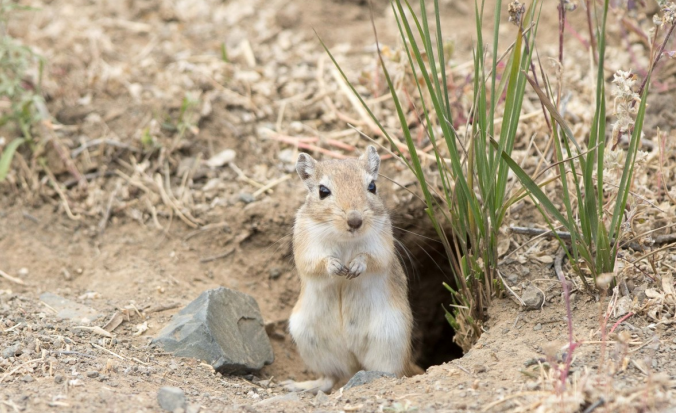
Mongolian Gerbil, Meriones unguiculatus
Pikas were everywhere in numbers unseen outside the Tibetan plateau. What species though was a bit of a mystery. Daurian and Pallas’s Pikas might be present in the area and seem impossible to distinguish unless you can get a look at the soles of their feet: the pads on the toes of the Pallas’s Pika are visible; those on the Daurian are covered in fur. So we spent a happy two hours failing to photograph Pika feet. A pika expert told me later that all the animals we saw appeared to be Pallas’s Pikas (Daurian Pika are far more secretive and fossorial).
Richard Webb’s group had seen Steppe Polecat here a year earlier during an evening in the park , which had pricked my interest in visiting. Today Tumen told us that James Eaton (from Birdtour Asia) had also seen a Steppe Polecat during his day in the valley: could this really be a Polecat hotspot? Given the huge biomass of pikas and gerbils it did seem quite plausible.
Tumen got permission for us to camp inside the park and at 21.30 we set off for a spotlight drive. Just five minutes into our drive we got some eyeshine on a hillside above the road and could see an animal lurking in some bushes and coming in and out of a burrow. We quickly identified it as a Polecat but which one? I thought it was Marbled but didn’t dare believe it. Twenty minutes later we had driven to within 20 metres of the hole and had repeated – albeit brief – views of a Marbled Polecat.
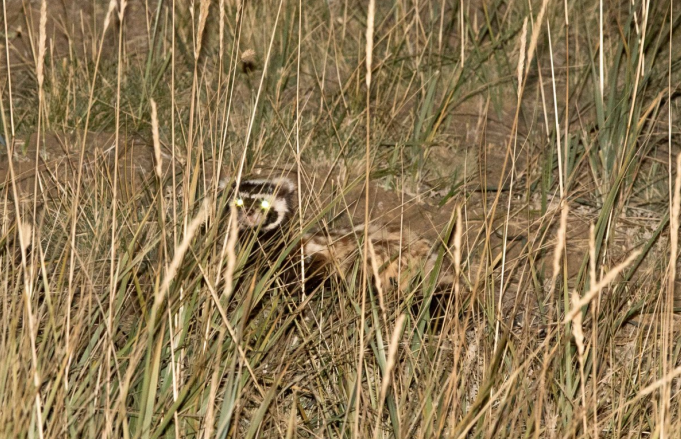
Marbled Polecat, Vormela peregusna
A gorgeous animal. Tumen believed he also saw a baby polecat in the grass behind it.
One of the many lists I let govern my life is a Top 21 Animals to See list, an attempt to add some quality to my mammal watching quantity. This year I had already seen two of my 21 species: Northern Right Whale Dolphins in California and now Bactrian Camels. Whenever I tick one off I replace it and the Bactrian Camel’s spot had been given to Marbled Polecat. Never had a species been on my top 21 wish list so briefly!
Overjoyed we continued up the gorge and took a side road where Richard Webb had seen Steppe Polecat. The moon was almost full and the temperature was rapidly dropping past freezing. Some 30 minutes after we had left the Marbled Polecat, and after a couple of Red Foxes, we got more polecatish eye shine. This time though – unbelievably – we had a Steppe Polecat about 50 metres away, hunting along a hillside. My flash batteries did not cope well with the low temperature so a great photo opportunity was lost (note to self, never buy Amazon Basic Batteries again).
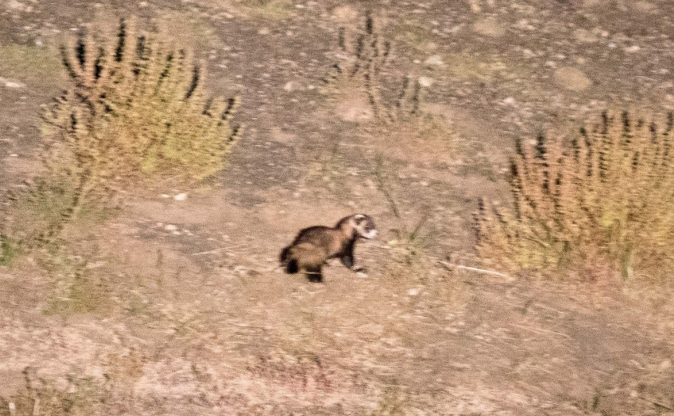
Steppe Polecat, Mustela eversmannii
Another beautiful animal. To see any polecat in an evening is something special. To see two species in an hour is unprecedented.
But the night wasn’t over. Twenty minutes further on Paul caught some eyeshine on a cliff which he quickly identified as Pallas’s Cat. Exciting for all of us, but especially for Phil who hadn’t seen this species despite several attempts.
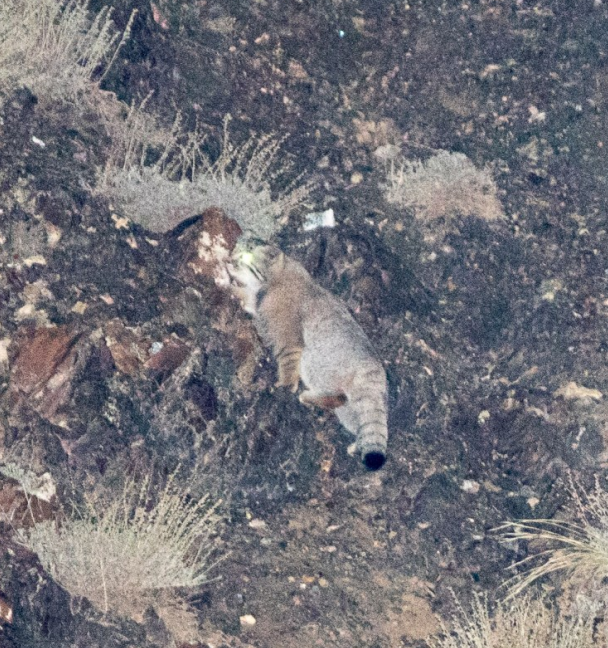
Pallas’ Cat, Otocolobus manu
We had a really great look at the beast as it climbed up the rocks and over the ridge. Again, my camera batteries let me down. But it would be churlish to complain.
A few minutes later we turned around and got more eyeshine near the Pallas’s Cat site on the way back. A small animal was bedded down in the long grass when we got the lights on it so Paul and I walked up the gorge for a closer look, getting to within 2 metres of the eyeshine before it revealed itself as a Pallas’s Cat that sprang into life and up the gorge. Presumably the same animal as earlier.
Ten minutes later we found a Beech Marten high up on the rocks and watched it scamper up the cliffs and out of site with impressive agility.
What a fabulous night! I must have spent 1000 nights spotlighting and this might just be the best ever. I’ve long had a theory that while many mammal species are rare there are reliable sites for all of them, even if we don’t know where they are yet. And, so far as I am concerned, Yolyn Am is the polecat capital of the world and should be on every mammal watcher’s Mongolian itinerary.
We had pencilled in a couple of nights at Yolyn Am. But after cleaning up so spectacularly we decided to start heading back to Ulaan Bataar and break the journey en route in the hope of some more Gobi small mammals. But first we had some traps to check, set around our camp among rocks and low Juniper shrubs. One in ten of the traps held an animal and they were new species too: we had caught four Dwarf Long-tailed Hamsters and two of the stunning Gobi-Altai Mountain Voles (the latter the most richly furred rodent I think I have ever encountered).
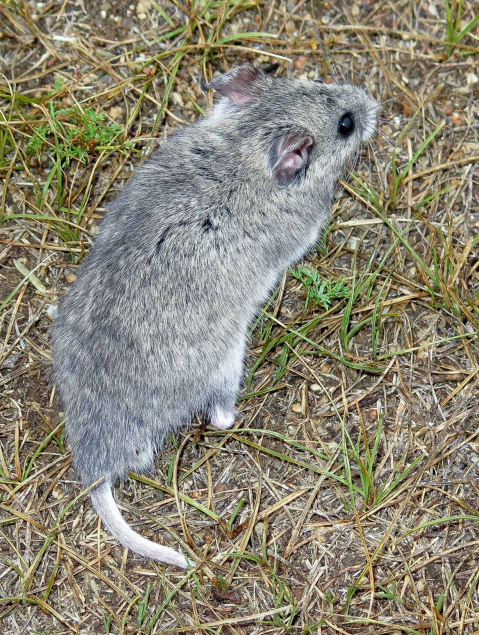
Long-tailed Dwarf Hamster, Cricetulus longicaudatus
According to the Mammals of Mongolia more work is needed to clarify the relationship between the Gobi-Altai Mountain Vole and the Narrow-headed Vole, but from the pictures in the book I’d be surprised if they were the same species.
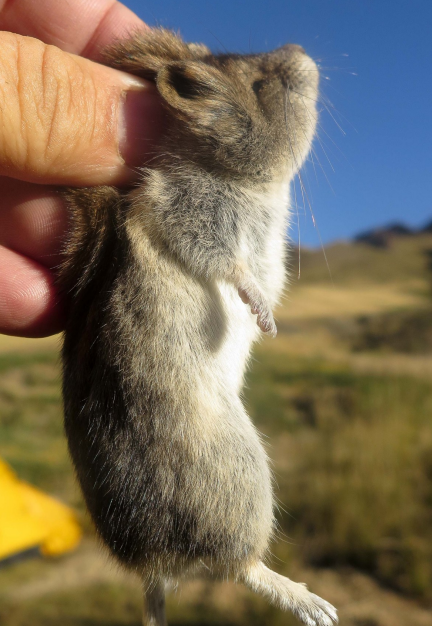
Gobi Altai Mountain Vole, Alticola barakshin
And then to Dalanzadgad and Tumen’s house for lunch and – oh joy – our first showers in more days that we cared to admit to.
We camped a couple of hours north of Dalanzadgad, near some sand dunes about 30km east of the highway (and about 30km north of Tsogt Ovoo). Spotlighting was disappointing but we did capture one of the only jerboas we saw. And our first definite Gobi Jerboa.
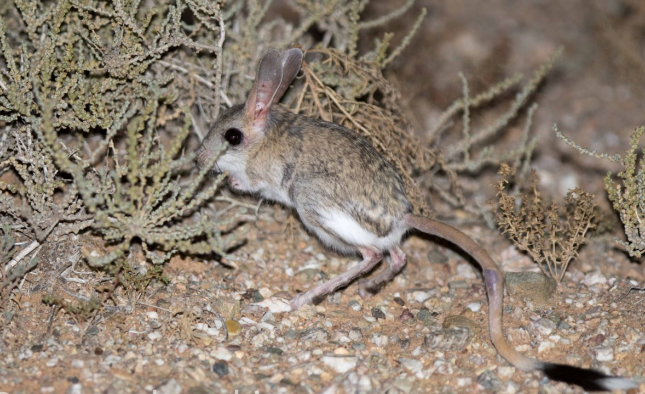
Gobi Jerboa, Allactaga bullata
There is considerably less white at the bottom of the tail tuft than in the otherwise similar looking Balikun Jerboa.
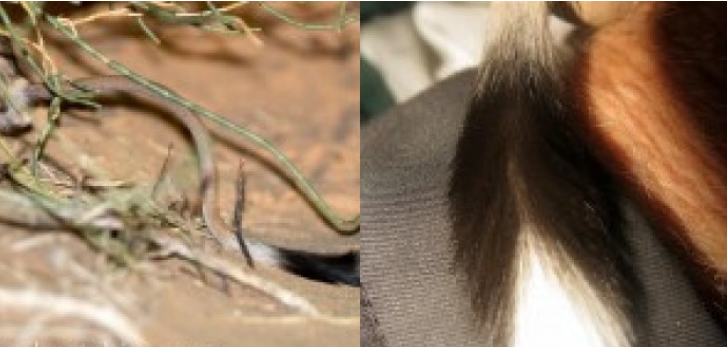
A Tail of Two Species: Balikun Jerboa (left), Gobi Jerboa (right)
There was very little in the traps in the morning: just a Desert Hamster and a Midday Gerbil.

Red Fox, Vulpes vulpes
As we returned to the highway we saw a very large herd – 1000 or so –Mongolian Gazelles. A beautiful moment to mark the end of the Gobi. And then it was a slow drive back to UB, followed by a long bath, a big steak and a soft bed.

Mongolian Gazelle, Procapra gutturosa
Phil and Paul had visited Hustai National Park, less than 2 hours south west of UB, before I had arrived in Mongolia. Paul decided to return with me, while Phil headed off for his last day or two with a Pallas’s Cat researcher to try to get some photos.
We got into Hustai about lunchtime. Though camping in the park is prohibited, Tumen arranged for us to stay in the research station (a basic house in the middle of the park). We also got permission to set small mammal traps.
I had a number of targets in the park, most notably the reintroduced Preswalski’s Horses.
Siberian Marmots were everywhere, though would presumably be underground within a few weeks. Great to get close to these photogenic beasts.
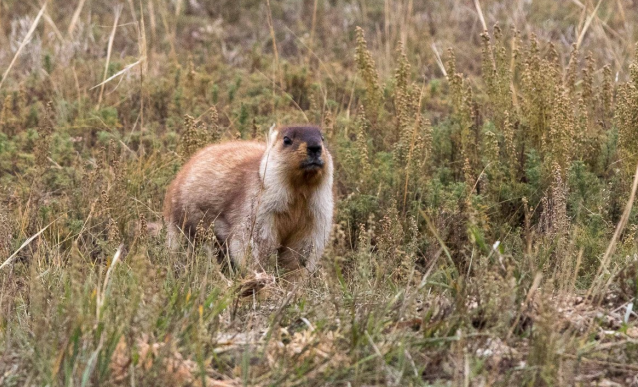
Siberian Marmot, Marmota sibirica
Long-tailed Ground Squirrels were common too, though despite intensive searching we could not see any Daurian Ground Squirrels. Paul and Phil had seen them 3 weeks earlier along the main road 2km or so from the park gate. I knew this species was going to be tricky; the males hibernate in August and the females in early September so I was relying on finding one of the sub-adult animals that apparently remain active until late September. And it was not to be although Paul thought he saw one dash across the road. The weather, for most of our time in Hustai, was overcast, cold, windy and a little damp which presumably didn’t help our chances.
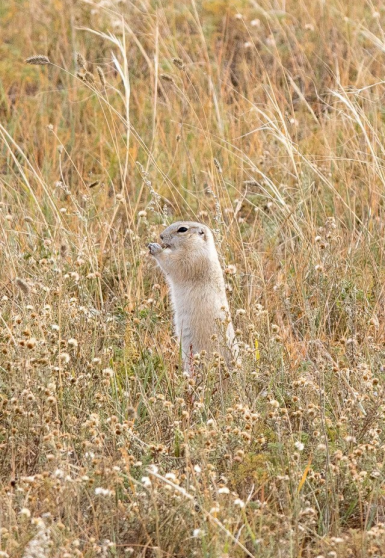
Long-tailed Ground Squirrel, Spermophilus undulatus
The Przewalski’s Horses were easy to spot, scattered on the hills through the valley. Beautiful things.
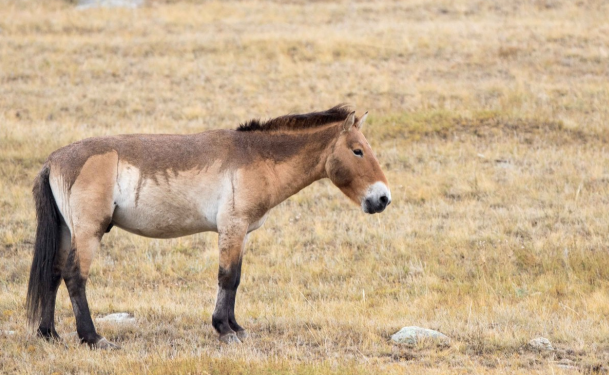
Przewalski’s Horse, Equus ferus
There were many many Red Deer too, and they could be heard bugling across the park,
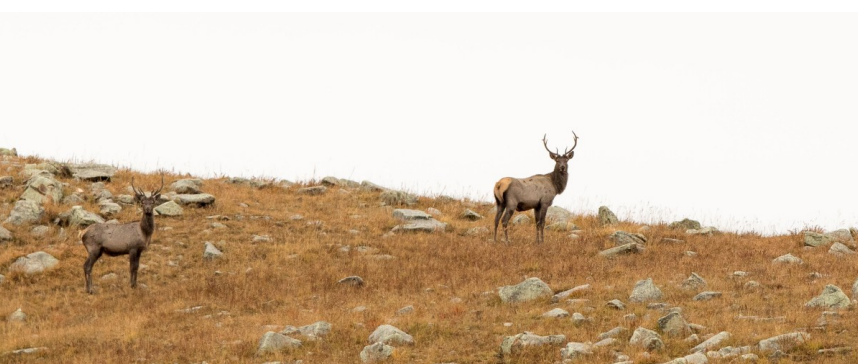
Red Deer (Elk), Cervus elaphus
A pack of Wolves were howling at dusk and Paul spotted them on a ridge close to the research centre.
Despite the cold weather, spotlighting that evening was successful. We saw at least 3 – possibly 4 – Steppe Polecats including prolonged views of one digging out a ground squirrel – or gerbil – burrow, breaking the digging every few seconds to check its
surrounding (perhaps looking to see if its prey had escaped) before disappearing into the hole. A little too far away to photograph well unfortunately.
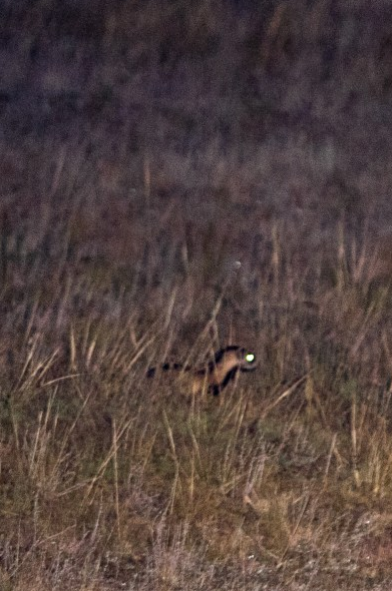
Steppe Polecat, Mustela eversmanni
We also saw both Red and Corsac Foxes.
Our traps around the research centre held a few Mongolian Gerbils, a Long-tailed Dwarf Hamster and the cracking little Striped Dwarf Hamster, the first of the trip, which steadfastly refused to pose for a picture.
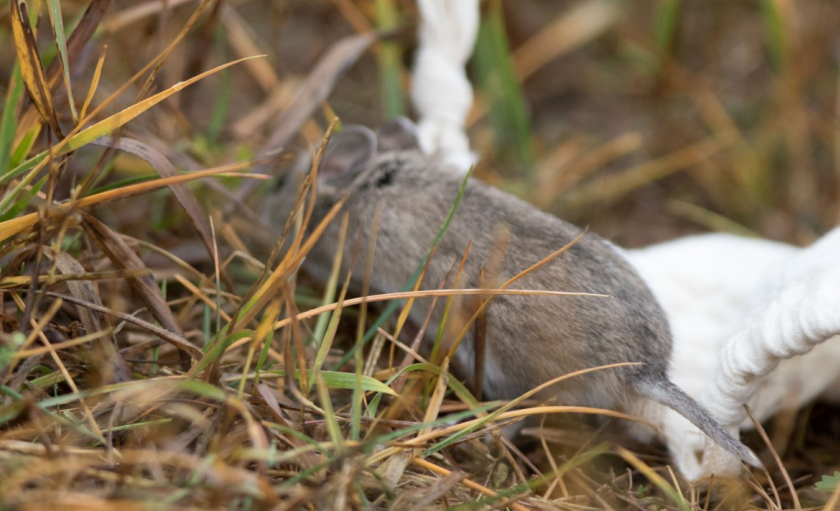
Striped Dwarf Hamster, Cricetulus barabensis
After searching again for Daurian Ground Squirrels we moved camp to the Moilt Camp area of the park, in a quite remote valley in the south west of the park, where there were plenty of rocks and trees and a promise of some new small mammals.
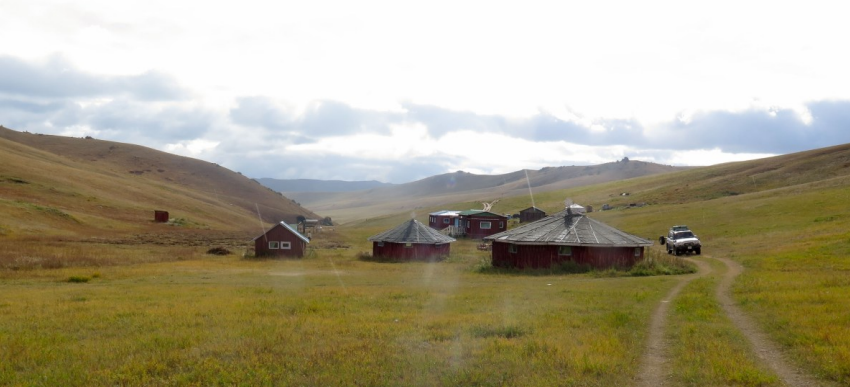
Moilt Camp, Hustai National Park
We had more Red Deer, Przewalski’s Horses and both Red and Corsac Foxes while spotlighting that night though we were too tired to stay out for long.
As we’d hoped our traps held some new species in the morning. A couple of chunky Reed Voles, too big to be Root Voles, and with 5 not 6 pads on their hind feet, trapped in the long grass next to camp.
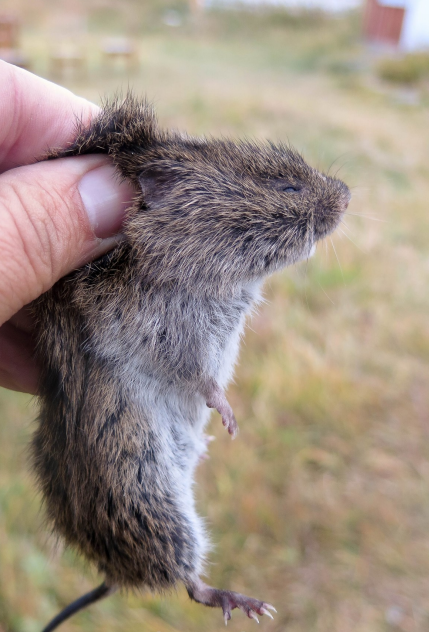
Reed Vole, Microtus fortis
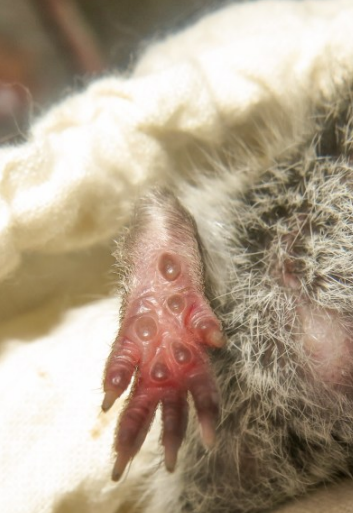
Reed Vole’s hind foot with give pads
We also caught a few of the gorgeous Silver Mountain Voles, trapped in the rocks up the valley from camp.
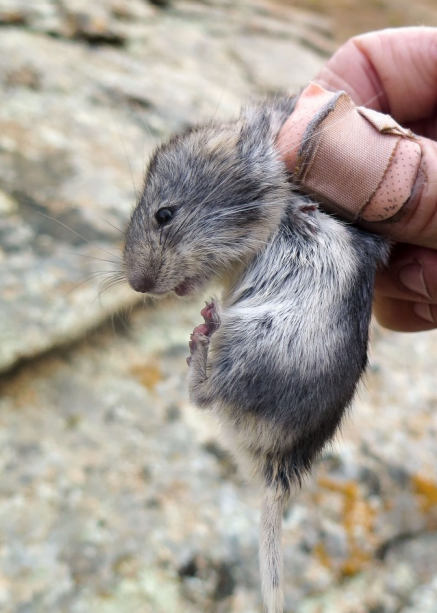
Mongolian Silver Vole, Alticola semicanus
As well as a single Grey-sided Red-backed Vole (Myodes rufocanus),which we initially recorded as M. rutilus, primarily on the basis of its tail length. Seems that the measurements in the Mammals of Mongolia book are wrong for this species, so thank you Andrey Lissovsky for the correction and giving me my 31st, and final, lifer for the trip.
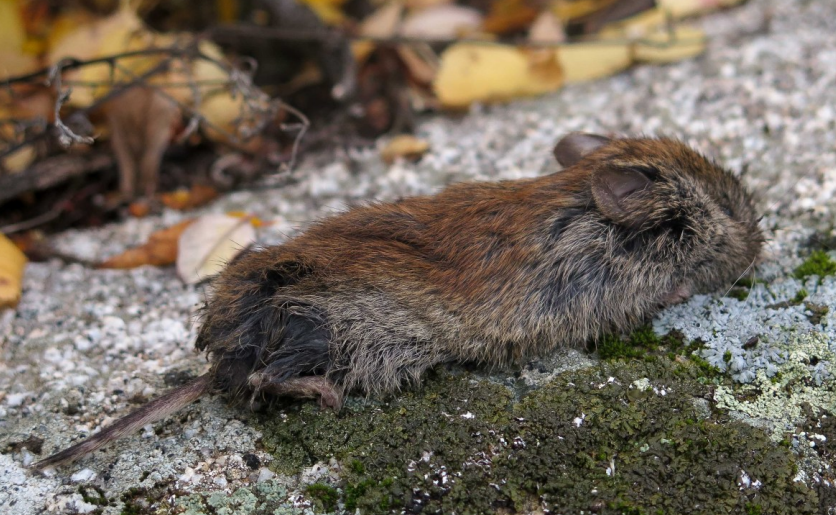
Grey-sided Red-backed Vole, Myodes rufocanus
And from there it was back to UB for a shower, lunch in the Irish pub and a flight home to New York via Beijing (where I failed again to find anAmur Hedgehog in the gardens of the Citic Airport Hotel).
What a great two weeks this was – one of the best trips I’ve ever taken. Mongolia is an exceptional country: so much space and freedom to explore. Although there seems to be a lot of hunting pressure on larger species the habitat seems largely untouched and so small mammals are flourishing there. There is no shortage of space.
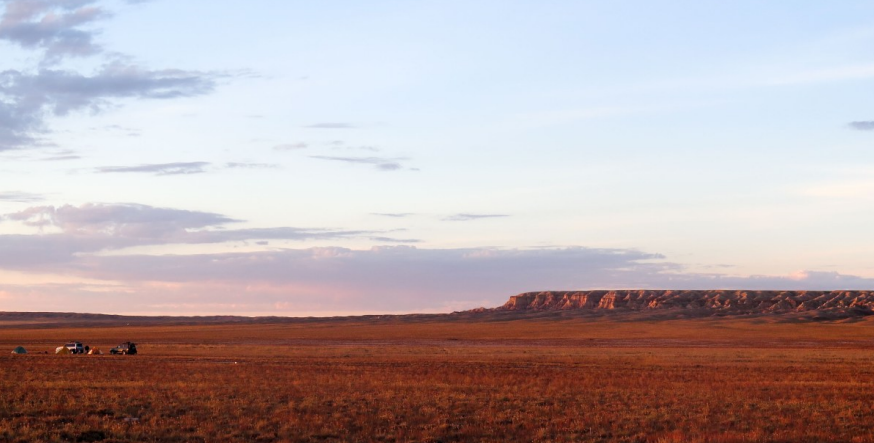
I owe a big thank you to Tumen and Oyuna for taking care of us so well and for their energy, enthusiasm and knowledge which all helped ensure we saw so much. Thanks too to Oggy and Eguuj for their hard work throughout the trip. And thank you to Richard Webb whose trip report provided extremely useful information and the inspiration to visit.

From left: Oggy, Paul, Phil, Jon, Oyuna, Tumen and Eguuj
With the exceptions of the species below we saw just about everything we might reasonably have wanted to see and a lot more besides.
Although Gobi Bear was one of the key animals for the trip it wasn’t one I particularly wanted to see and so I didn’t lose any sleep once I realised how difficult it was likely to be. Richard’s group got a lot closer than we did but without food in the feeding stations I suspect the bears are all but impossible to bump into.
We had an eye out at all times for Lynx and Snow Leopard too but, again, these weren’t really a focus for the trip so they didn’t distract us too much. With some better planning on my part I think I would have seenDaurian Ground Squirrel. I could for instance, have stopped into Hustai on my way down to Bayahongor (its just a 13km detour to the park gate) but I didn’t think of that.
F Pallas’ Pika Ochotona pallasii: abundant at Yolyn Am with a few at Zoolon Mountain, Tolai Hare Lepus tolai: seen most days
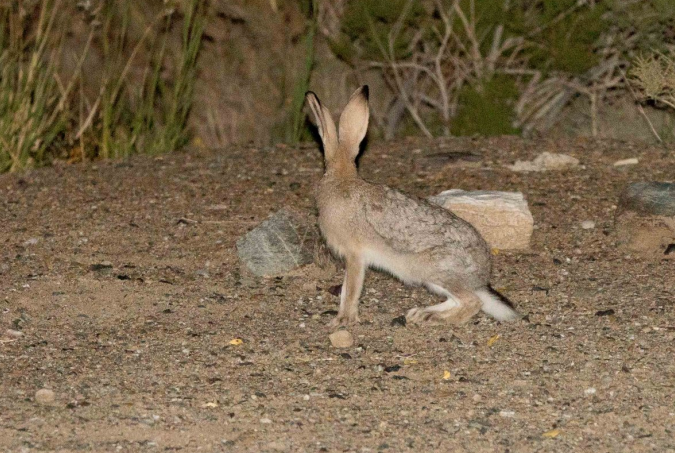
Tolai Hare, Lepus tolai
F Siberian Marmot Marmota sibirica
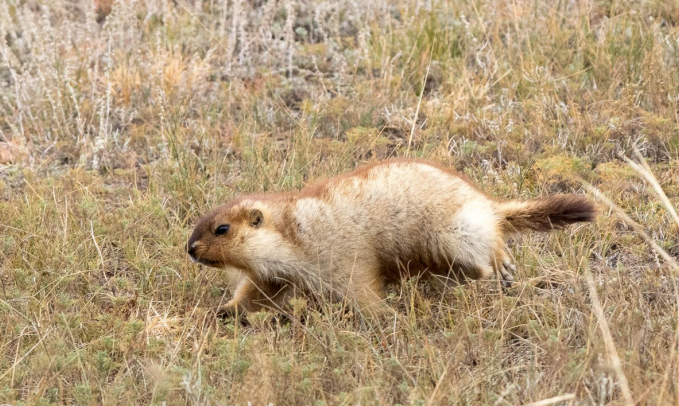
Siberian Marmot, Marmota sibirica
F Red-cheeked Ground Squirrel Spermophilus erythrogenys: just one about 90 minutes west of Bayahongor
F Ala Shan Ground Squirrel Spermophilus alashanicus: several at Zoolon Mountain and a few at Yolyn Am
F Long-tailed Ground Squirrel Spermophilus undulatus: common at Hustai
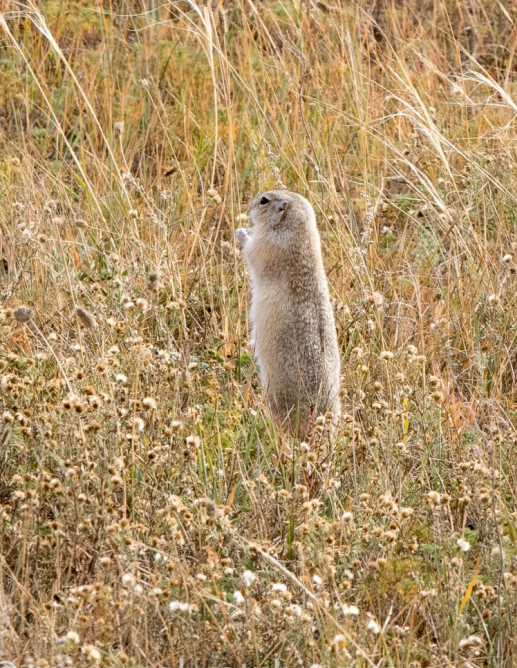
Long-tailed Ground Squirrel, Spermophilus undulatus
F Balikun Jerboa Allactaga balikunica: probably seen fairly often in the Gobi but only confirmed once (on day 9).
F Gobi Jerboa Allactaga bullata: probably seen fairly often in the Gobi but only confirmed once (on day 12).
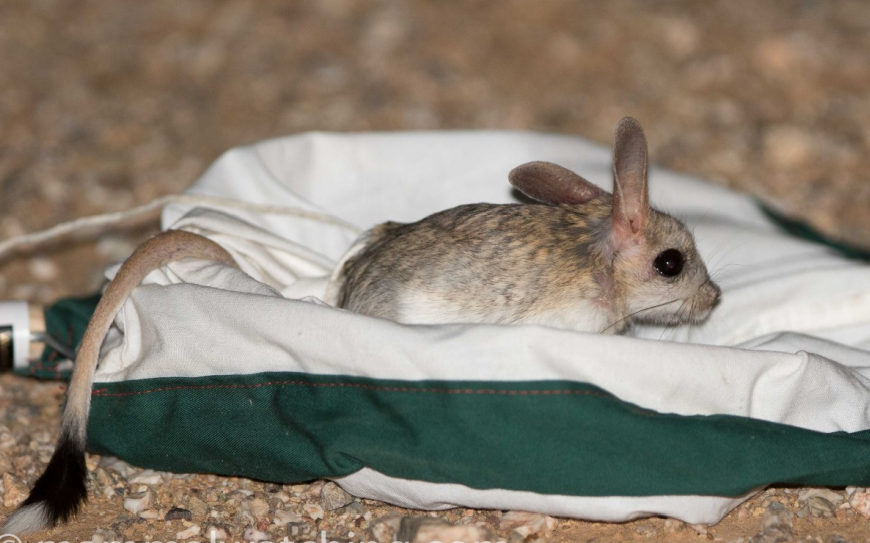
F Mongolian Five-toed Jerboa Allactaga sibirica probably seen fairly often in the Gobi but only confirmed once (on days 8 & 9). This is the nly Jerboa in Hustai, though I didn’t see it there.
F Northern Three-toed Jerboa Dipus sagitta: quite common and easy to catch in several places around the Gobi.
F Andrews’ Three-toed Jerboa Stylodipus andrewsi: only confirmed once on day 3, though after this we didn’t try catching animals that looked like this species or D. sagitta. F Five-toed Pygmy Jerboa Cardiocranius paradoxus: seen several times and easy to catch.
F Thick-tailed Pygmy Jerboa Salpingotus crassicauda: seen several times and easy to catch.
F Kozlov’s Pygmy Jerboa Salpingotus kozlovi: seen several times and easy to catch.
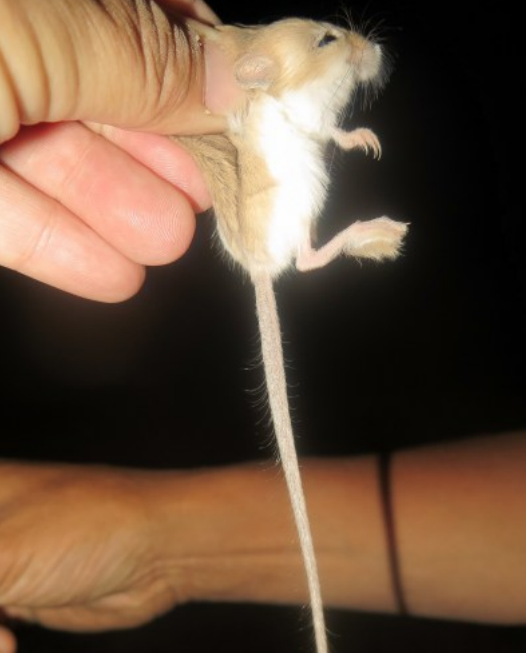
Kozlov’s Pygmy Jerboa, Salpingotus kozlovi
F Long-eared Jerboa Euchoreutes naso: a key species for the trip and we found one after a short search at Eyhins Gols but did not find any more.
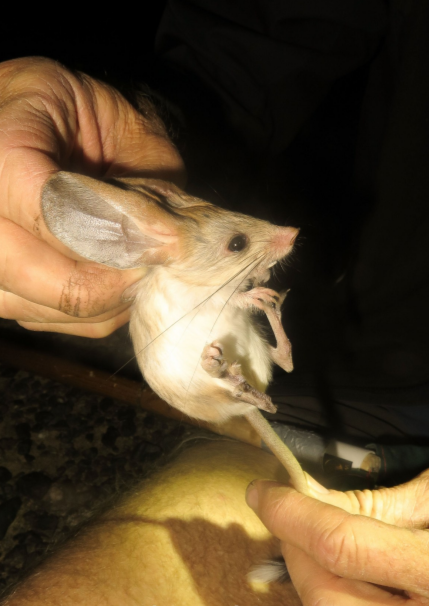
Long-eared Jerboa, Euchoreutes naso
F Striped Dwarf Hamster Cricetulus barabensis: one trapped in Hustai near the research station.
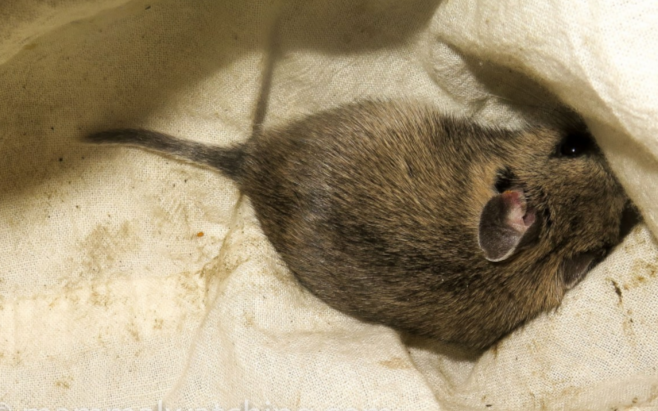
Striped Dwarf Hamster, Cricetulus barabensis
F Long-tailed Dwarf Hamster Cricetulus longicaudatus: trapped in Hustai and Yolyn Am.
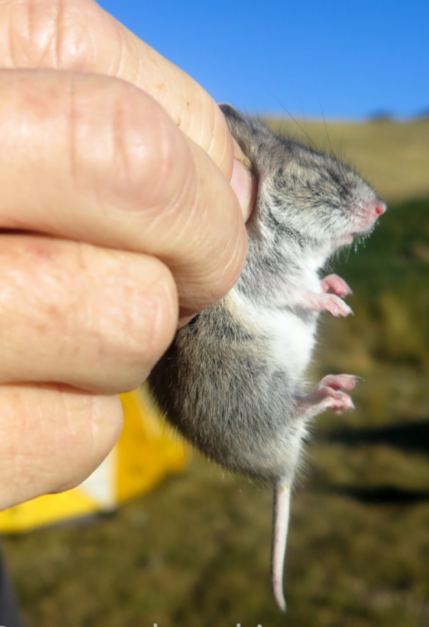
Long-tailed Dwarf Hamster, Cricetulus longicaudatus
Gray Dwarf Hamster Cricetulus migratorius: the most commonly trapped hamster and we caught them in several locations, usually near rocks.
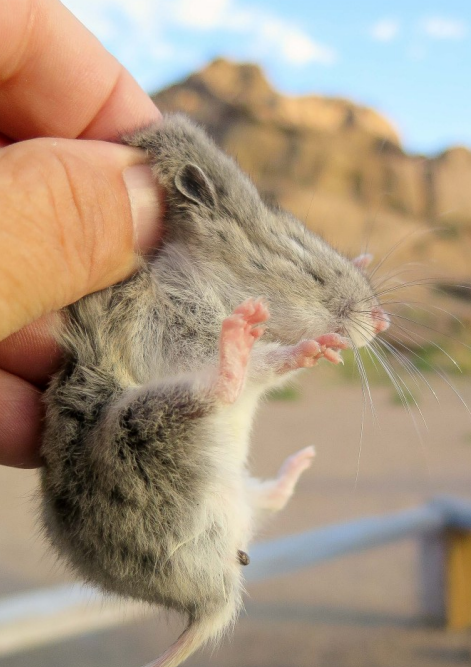
Gray Dwarf Hamster, Cricetulus migratorius
F Desert Hamster Phodopus roborovskii: a few caught in several locations in sandy habitat.
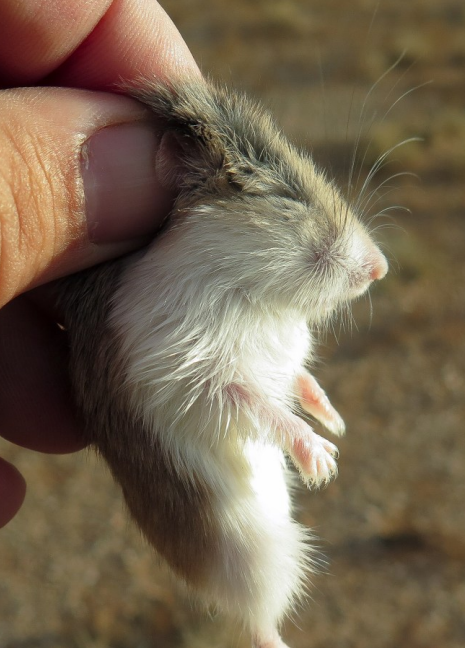
Desert Hamster, Phodopus roborovskii
F Reed Vole Microtus fortis: caught in dense shrubby vegetation near Moilt Camp, Hustai.
F Brandt’s Vole Lasiopodomys brandtii abundant in the Tuin River Valley with anothercolony in the Altai Mountains on day 2.
F Gobi Altai Mountain Vole Alticola barakshin: a couple trapped at Yolyn Am among the rocks and Juniper.
F Mongolian Silver Vole Alticola semicanus: a few caught among big rocks near Moilt Camp, Hustai.
F Grey-sided Red-backed Vole Myodes rufocanus: one among birch trees and rocks near Moilt Camp, Hustai.
Mid-day Gerbil Meriones meridianus: abundant throughout the Gobi and active in the day time at Yolyn Am.
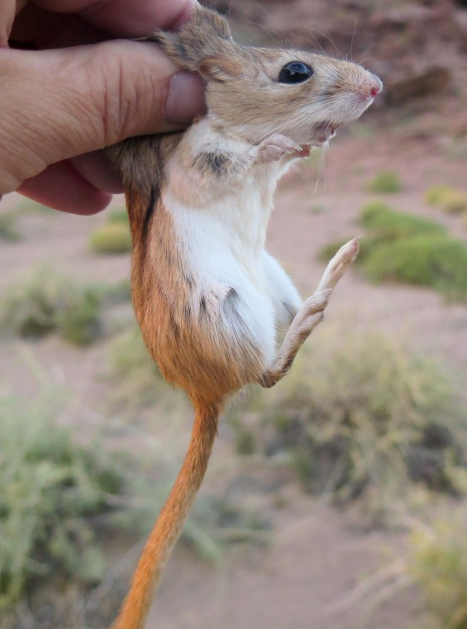
Mid-day Gerbil, Meriones meridianus
F Mongolian Gerbil Meriones unguiculatus: common at Yolyn Am and a few at Hustai.
F Great Gerbil Rhombomys opimus: easy to see in their colonies such as the one in Saxual “forest” at Mother Mountain.
Pallas’ Cat Otocolobus manul: one spotlit at Yolyn Am.
Corsac Fox Vulpes corsac: several seen at Hustai, and one or two seen in the Gobi.
Red Fox Vulpes vulpes: common in the Gobi and at Hustai.
Gray Wolf Canis lupus: one at Zoolong Mountain and several seen or heard in Hustai.
Beech Marten Martes foina: one at Yolyn Am.
F Steppe Polecat Mustela eversmannii: one spotlit at Yolyn Am and at least three separate sightings in Hustai on the main road between the research centre and the north gate.
F Marbled Polecat Vormela peregusna: one just after dusk ni Yolyn Am. One of the mammals of the trip for sure.
Long-eared Hedgehog Hemiechinus auritus: several seen and trapped at Shar Xuls.
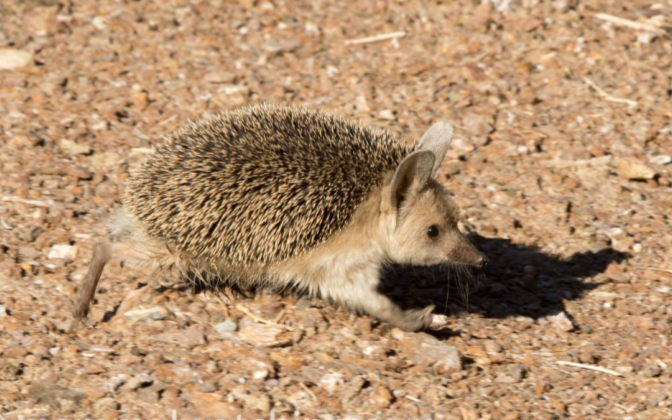
Long-eared Hedgehog, Hemiechinus auritus
F Gmelin’s Shrew Crocidura gmelini: one trapped and another spotlit at Shar Xuls.
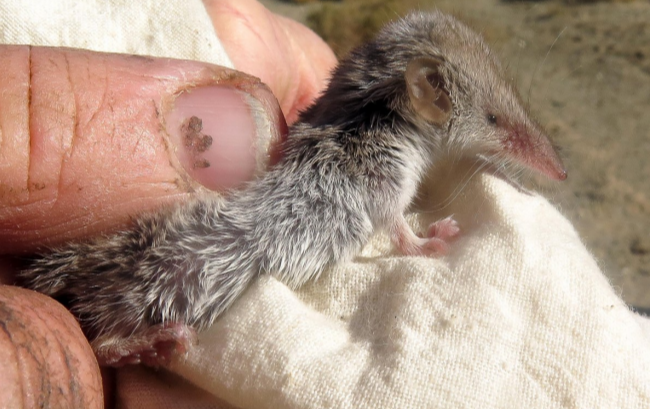
Gmelin’s Shrew, Crocidura gmelini
F Alashanian Pipistrelle Pipistrellus alaschanicus: one caught in a net across the creek at Shar Xuls. I have never seen a bat as relaxed about being captured.
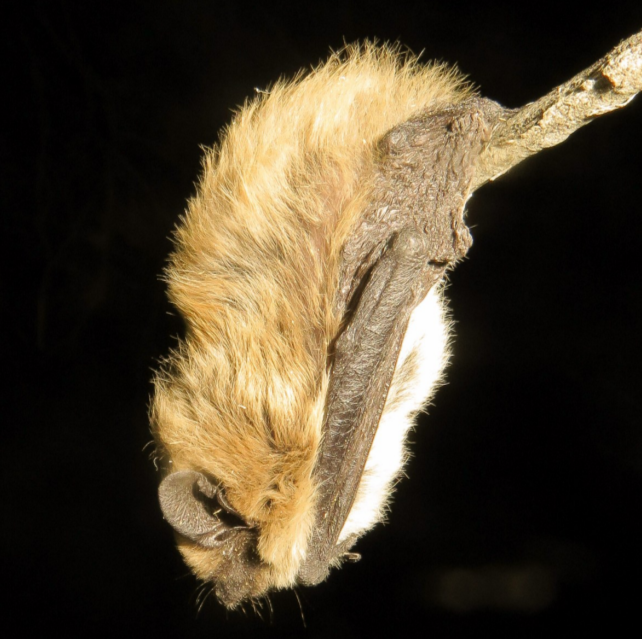
Alashanian Pipistrelle, Pipistrellus alaschanicus
F Wild Bactrian Camel Camelus ferus: four semi-habituated animals between Mother Mouhtain and Buyantooroy and another not at all habituated at Shar Xuls.
Red Deer (Elk) Cervus elaphus: common at Hustai.
Black-tailed (Goitered) Gazelle Gazella subgutturosa: seen every day in the Gobi.
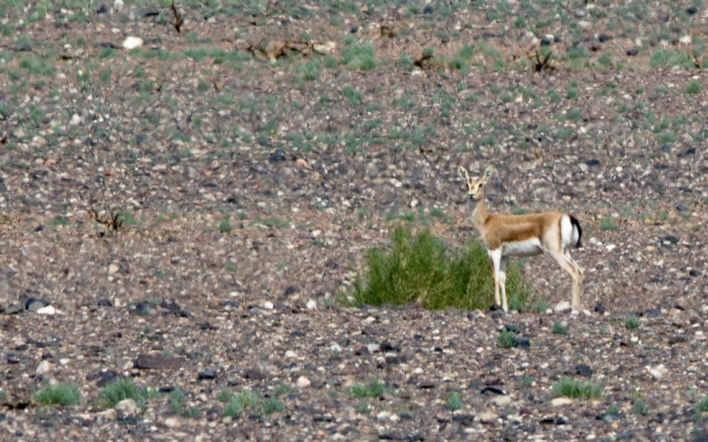
Black-tailed (Goitered) Gazelle, Gazella subgutturosa
F Mongolian Gazelle Procapra gutturosa: a herd between Zoolon Mountain and Yolyn Am, and a large herd about 2 hours north of Dalanzadgad.
Siberian Ibex Capra sibirica: a few around Zoolong Mountain.
Argali Ovis ammon: a few around Shar Xuls.
F Przewalski’s Horse Equus ferus: common at Hustai.
Asiatic Wild Ass Equus hemionus: plenty of droppings and tracks around Shar Xuls but only one animal seen.
45 species, with 31 lifers (marked F).
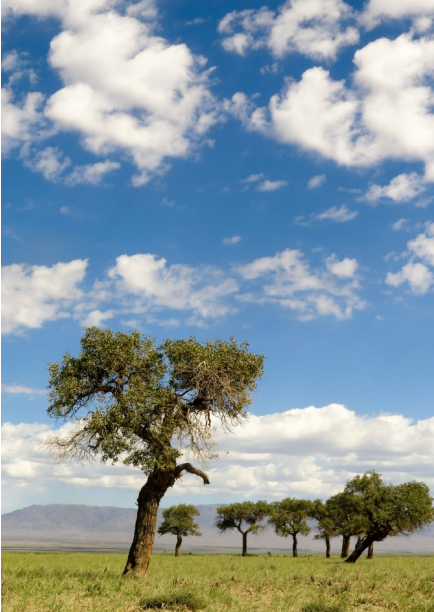
Gobi oasis.
© 2025 Tum-Eco Tour Co.,Ltd. All right reserved. Developed by Mind Agency